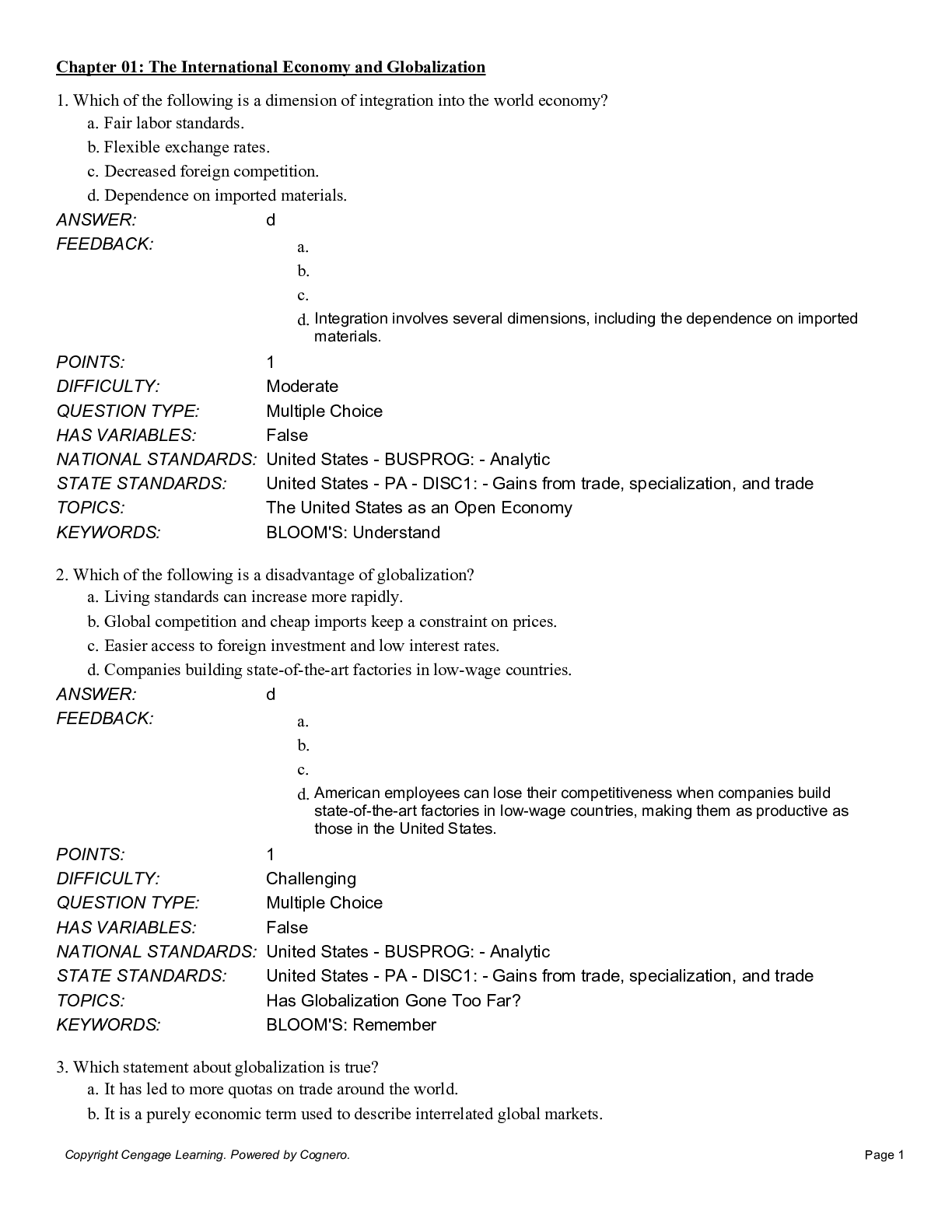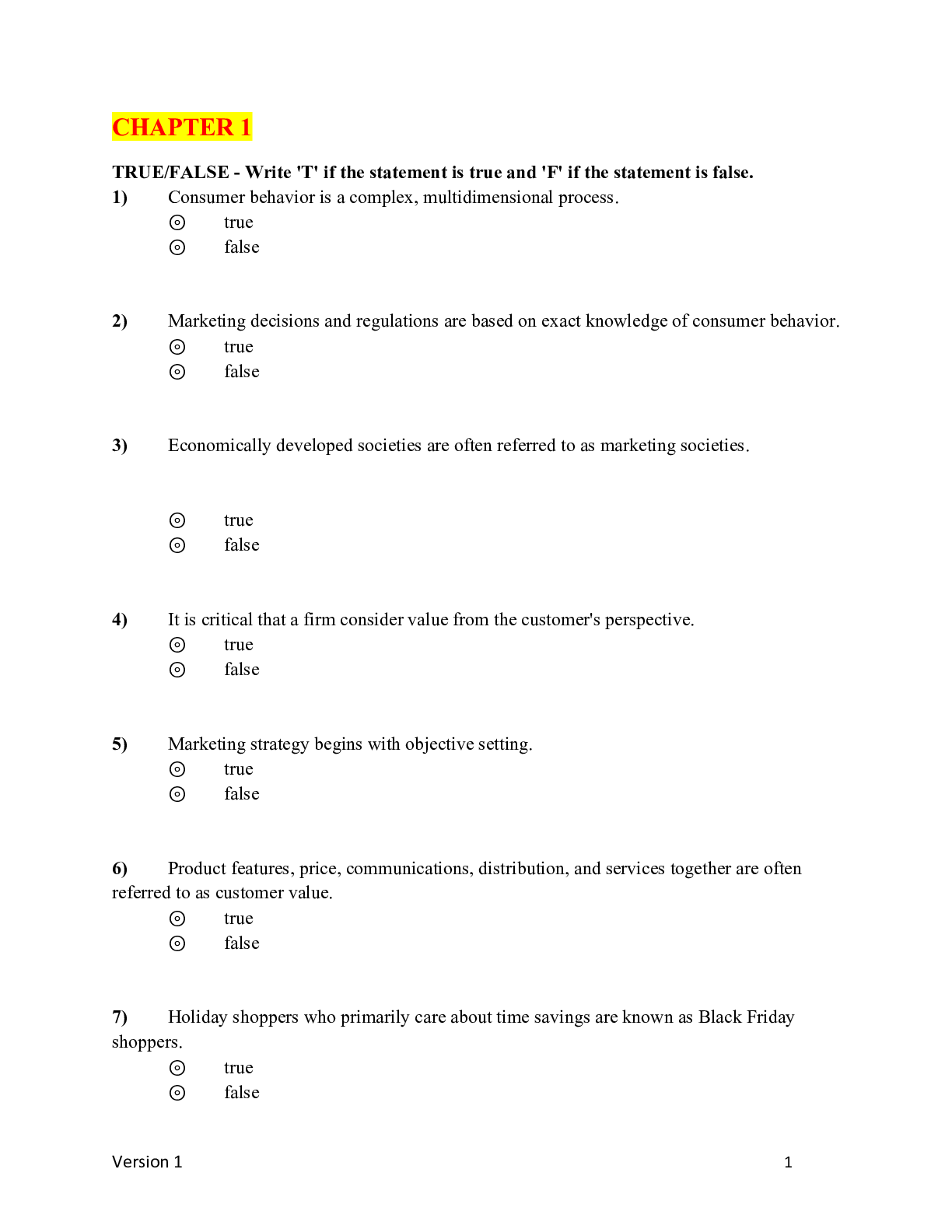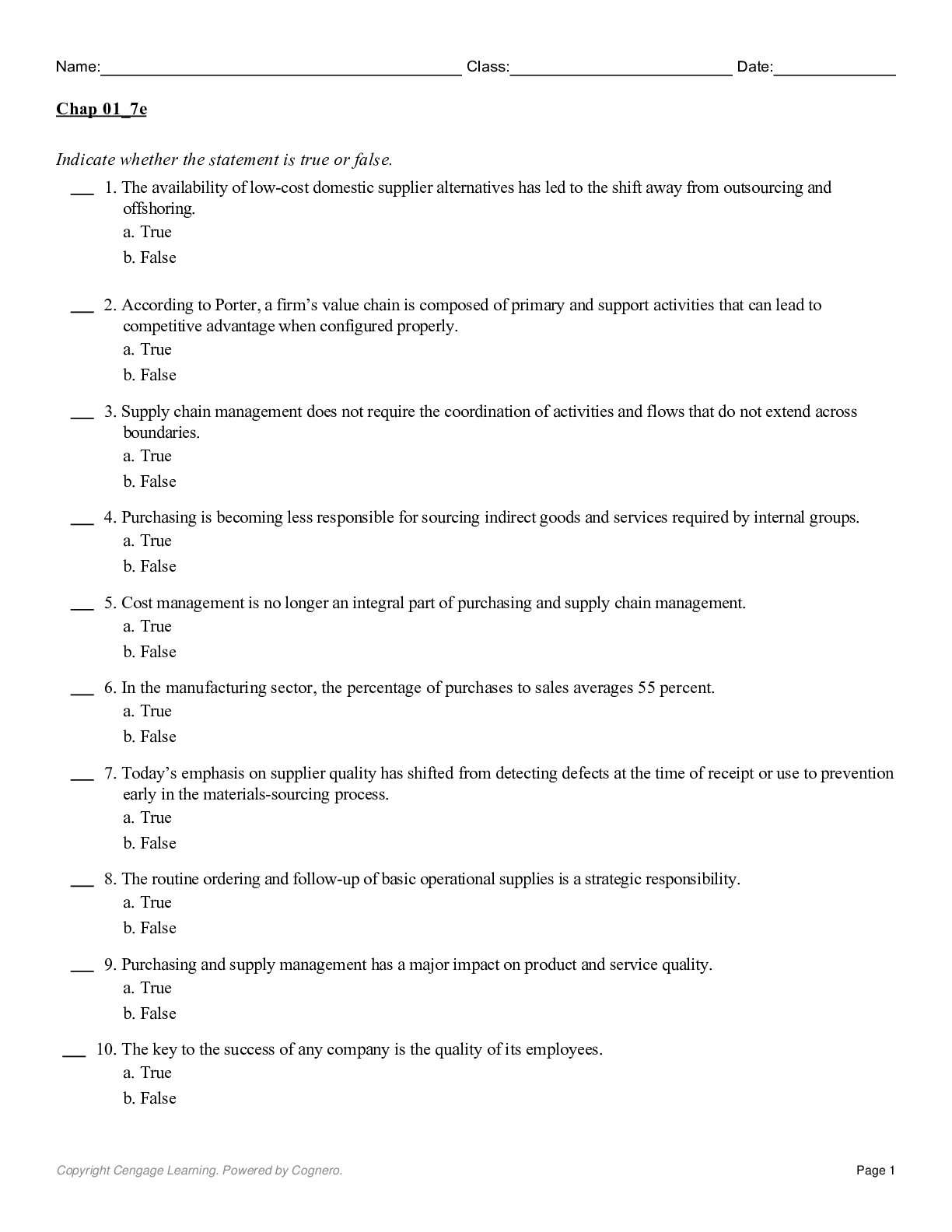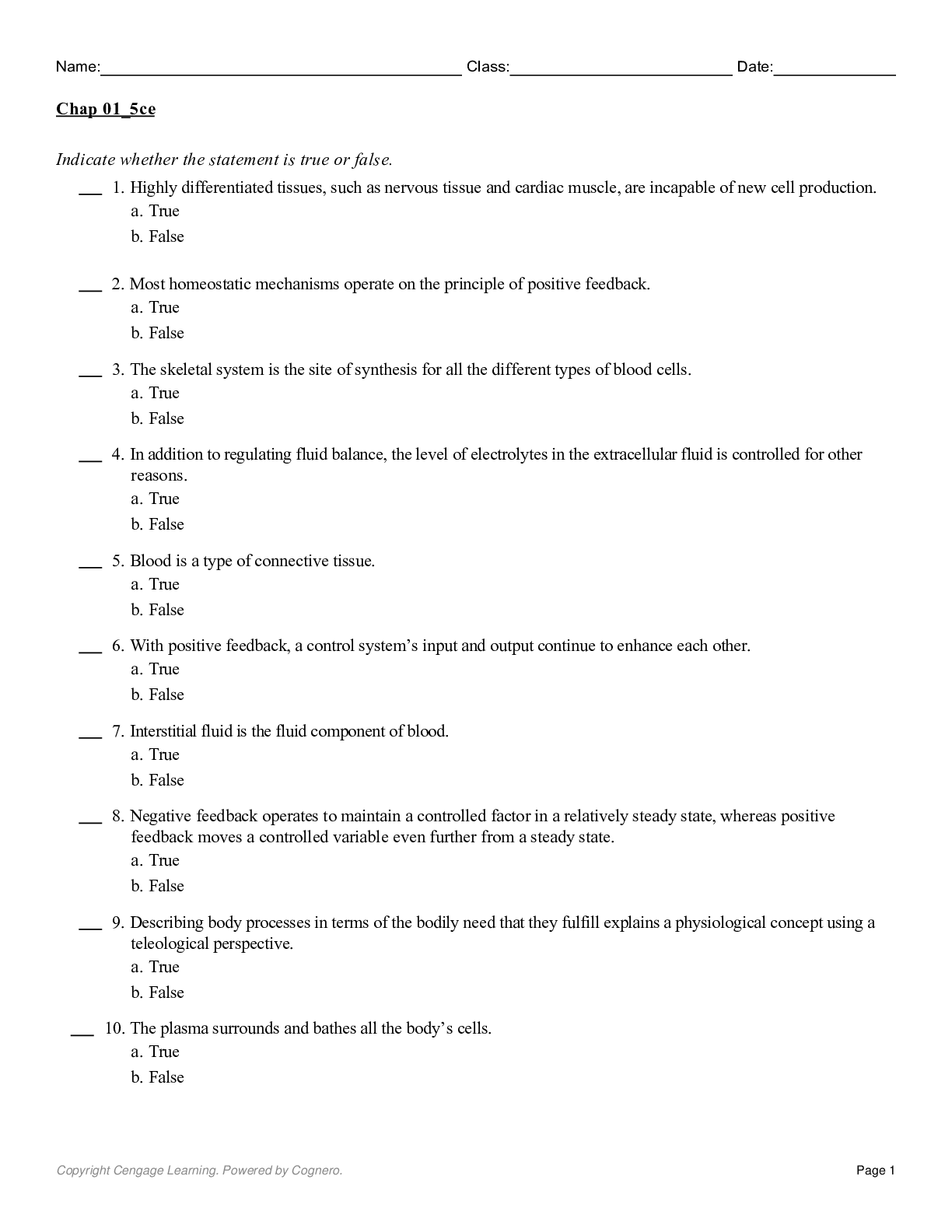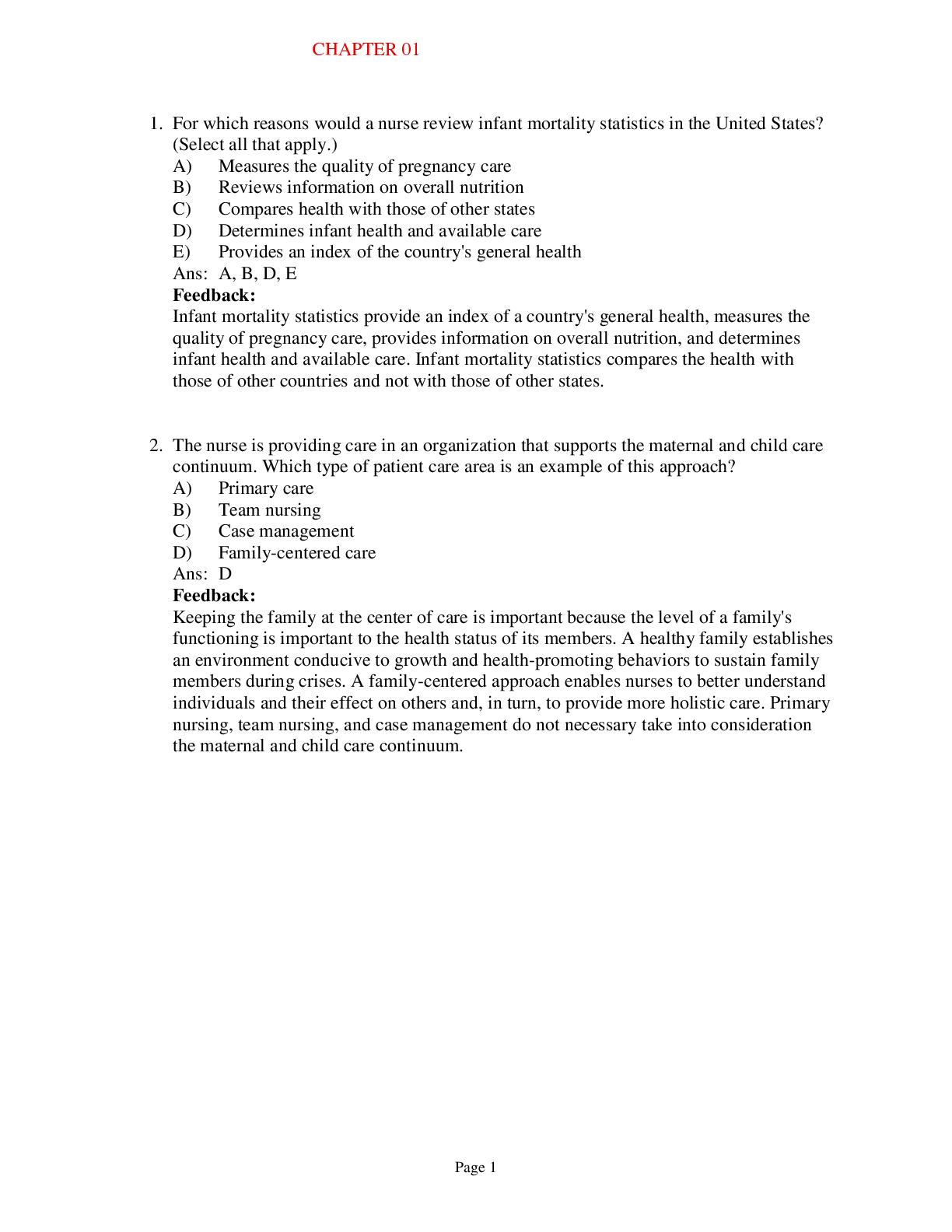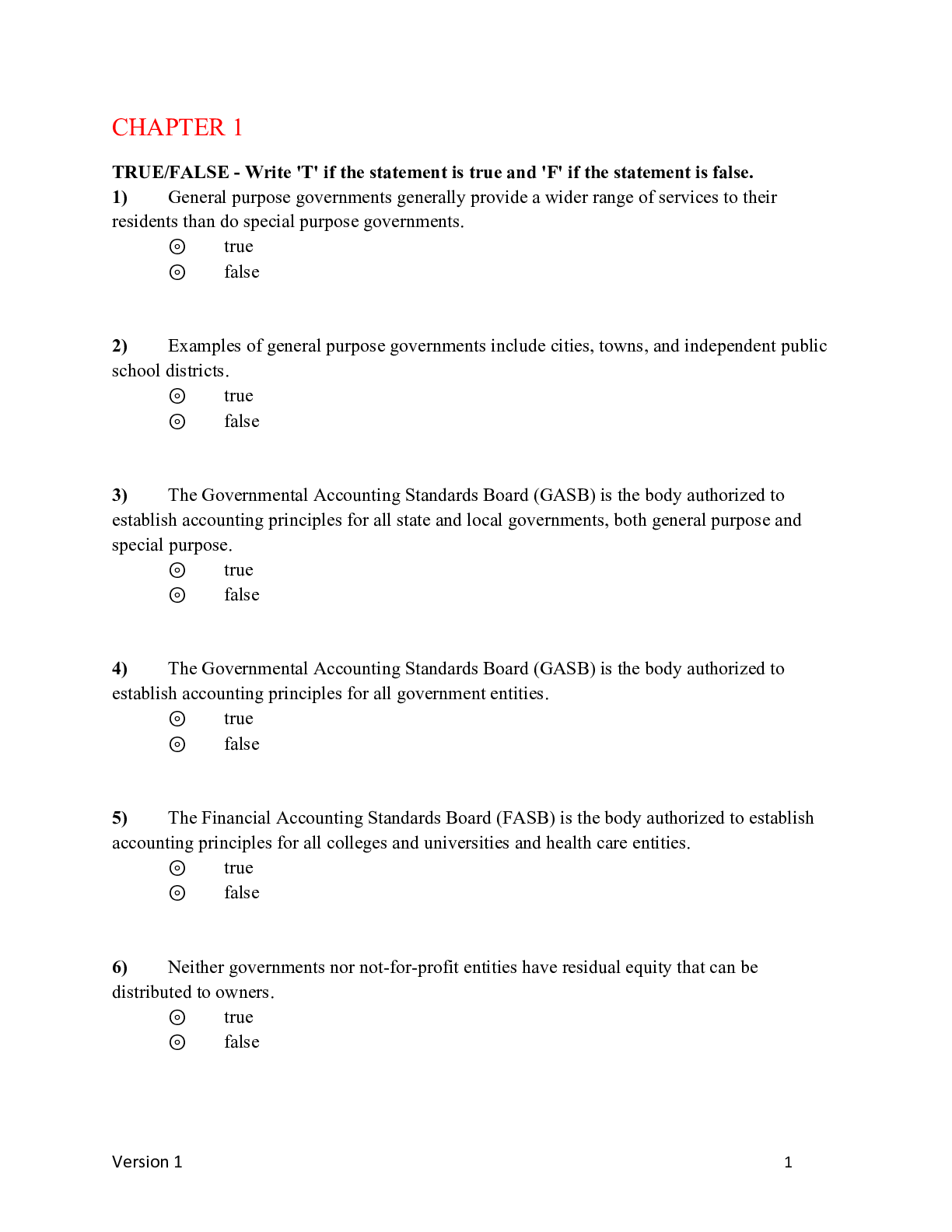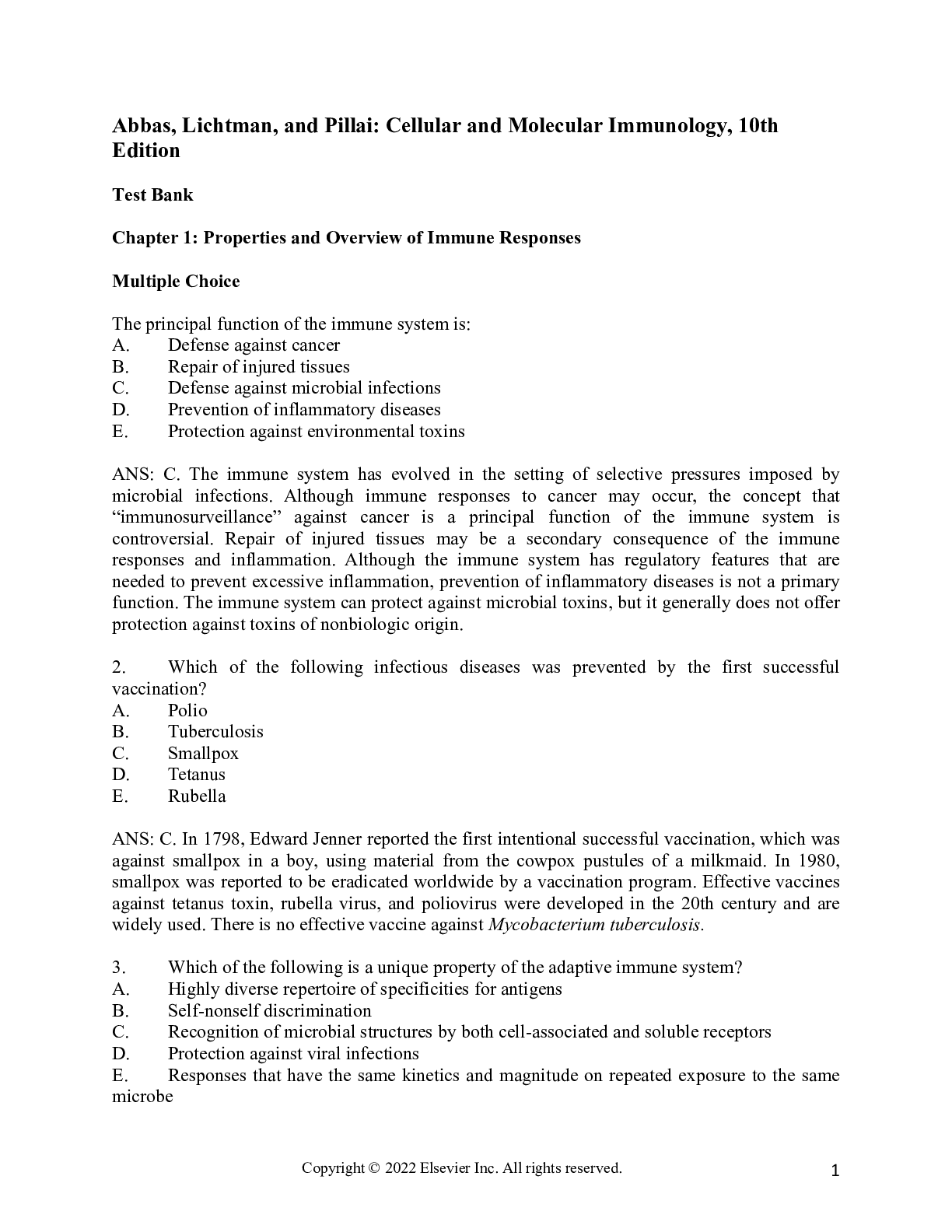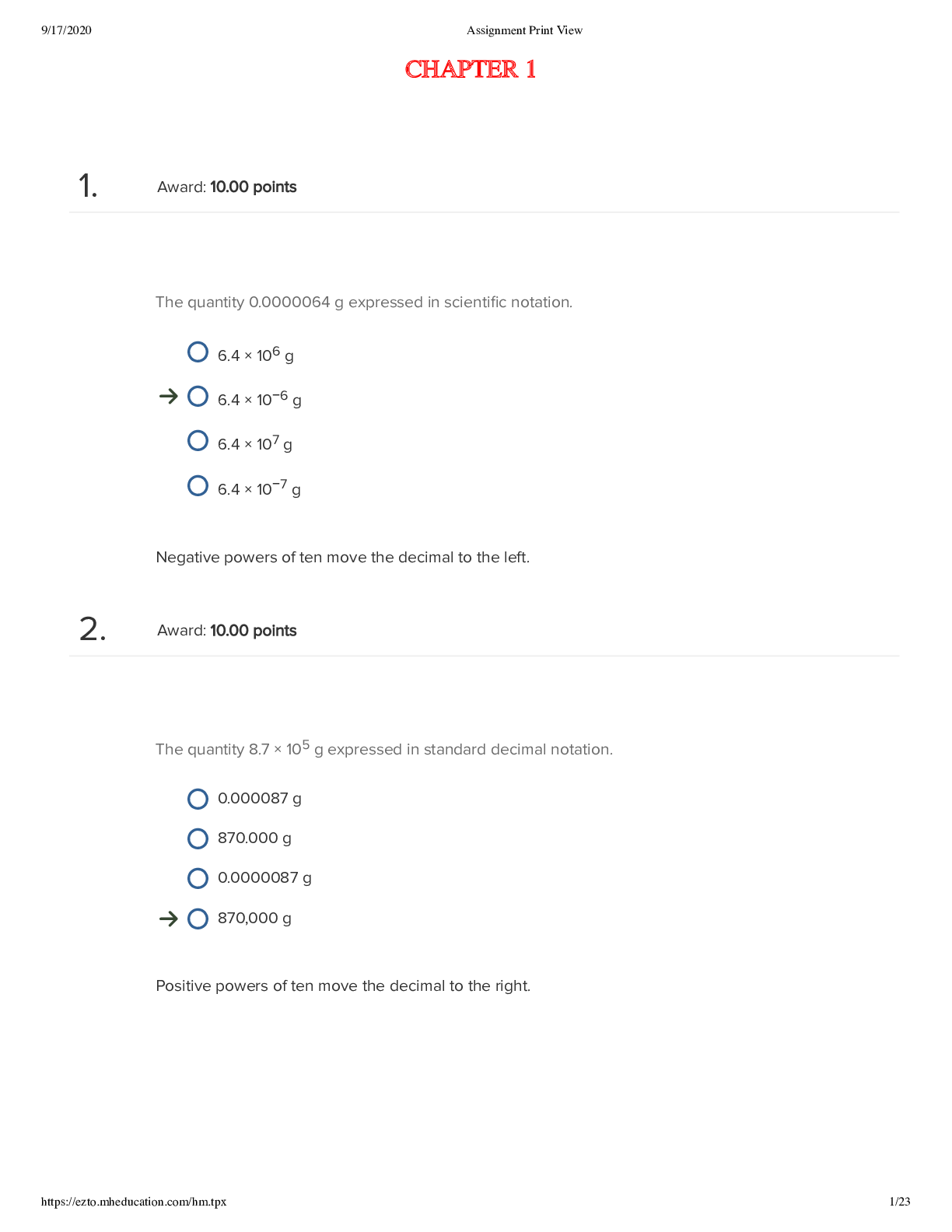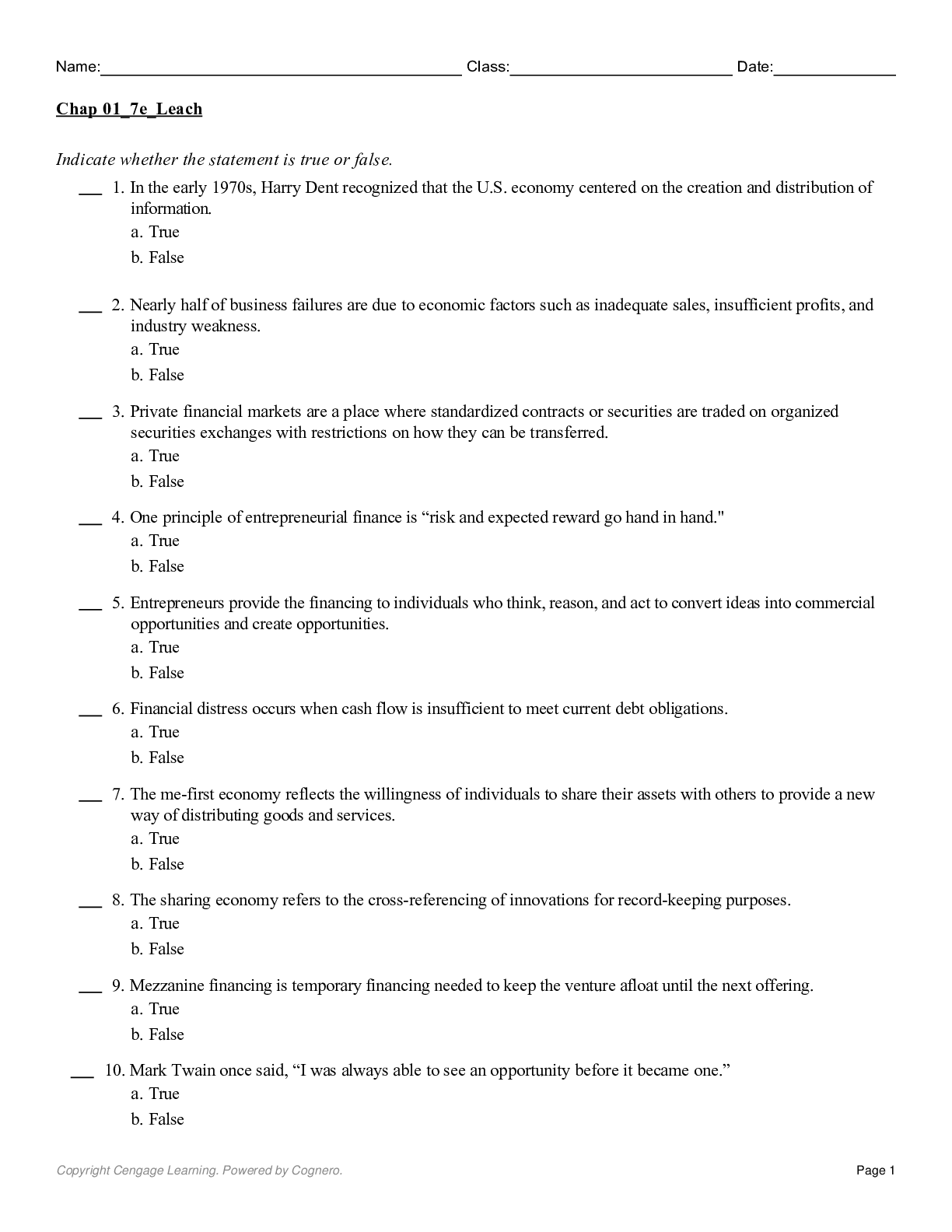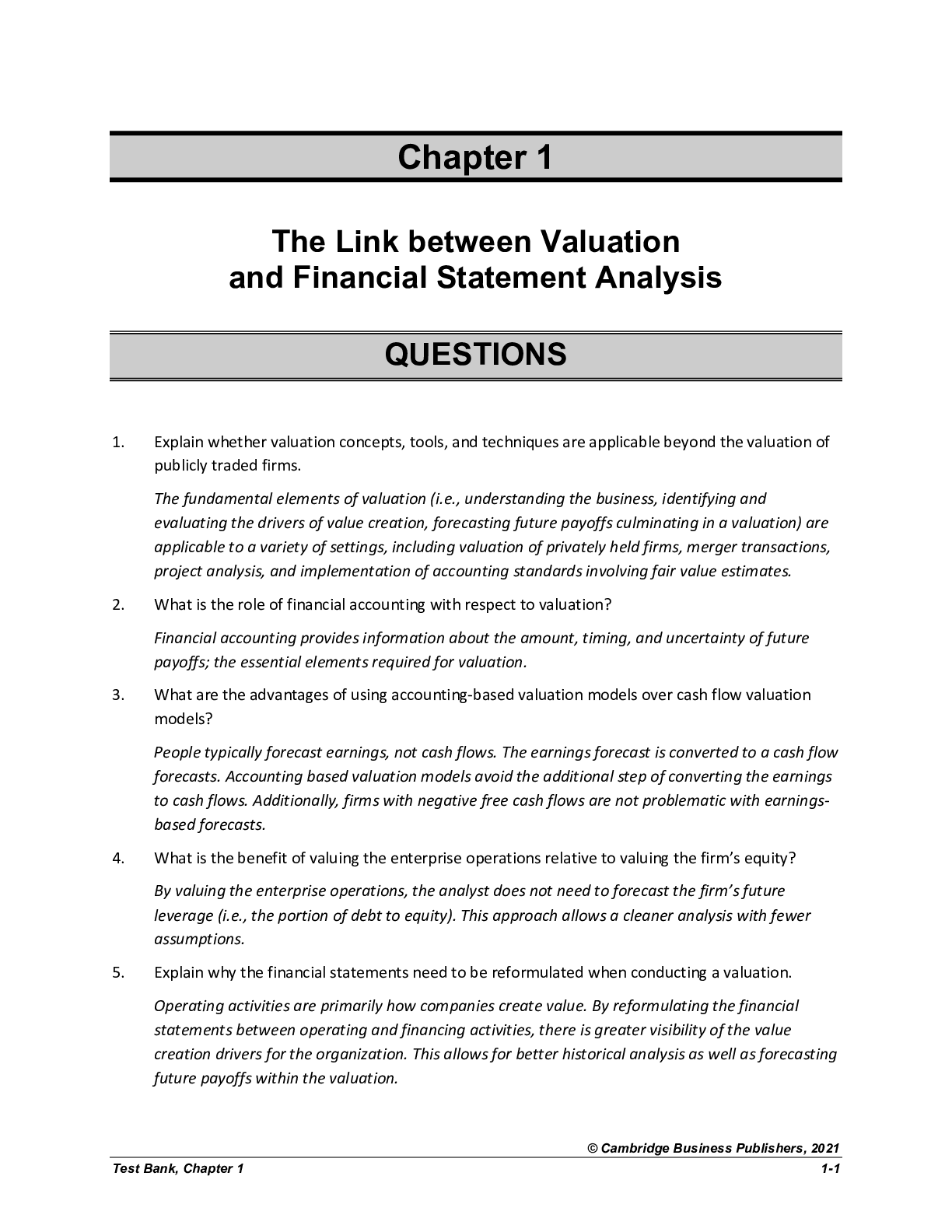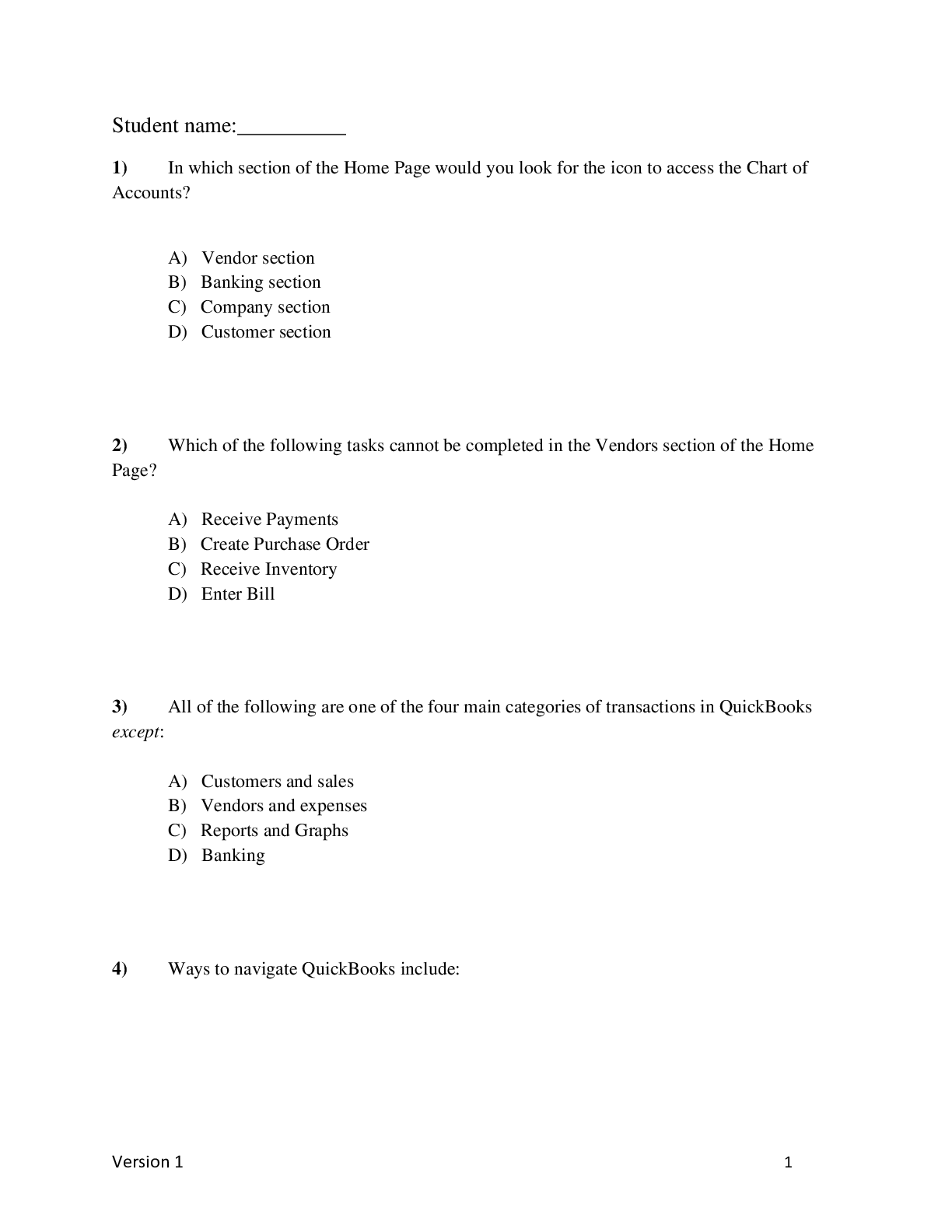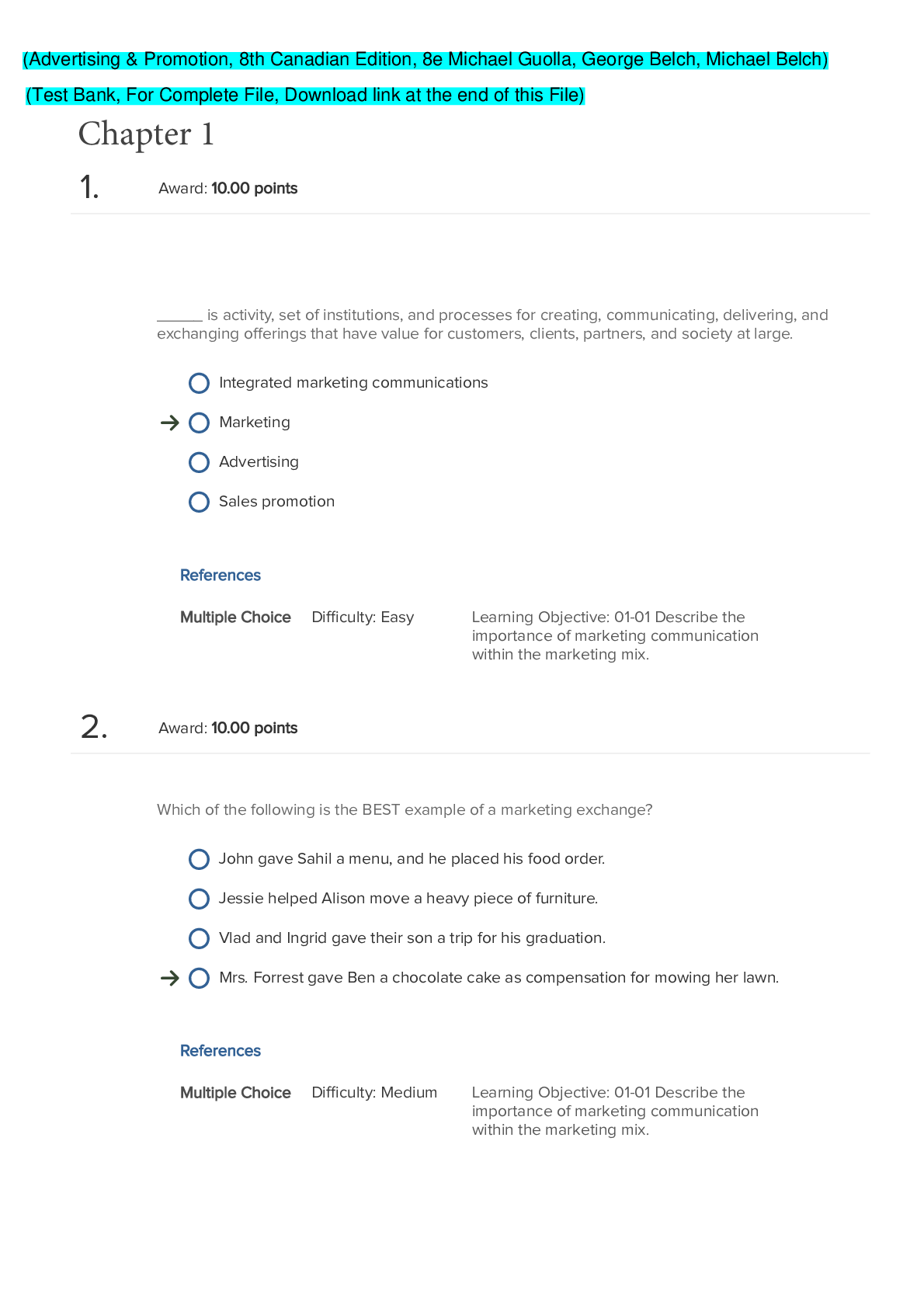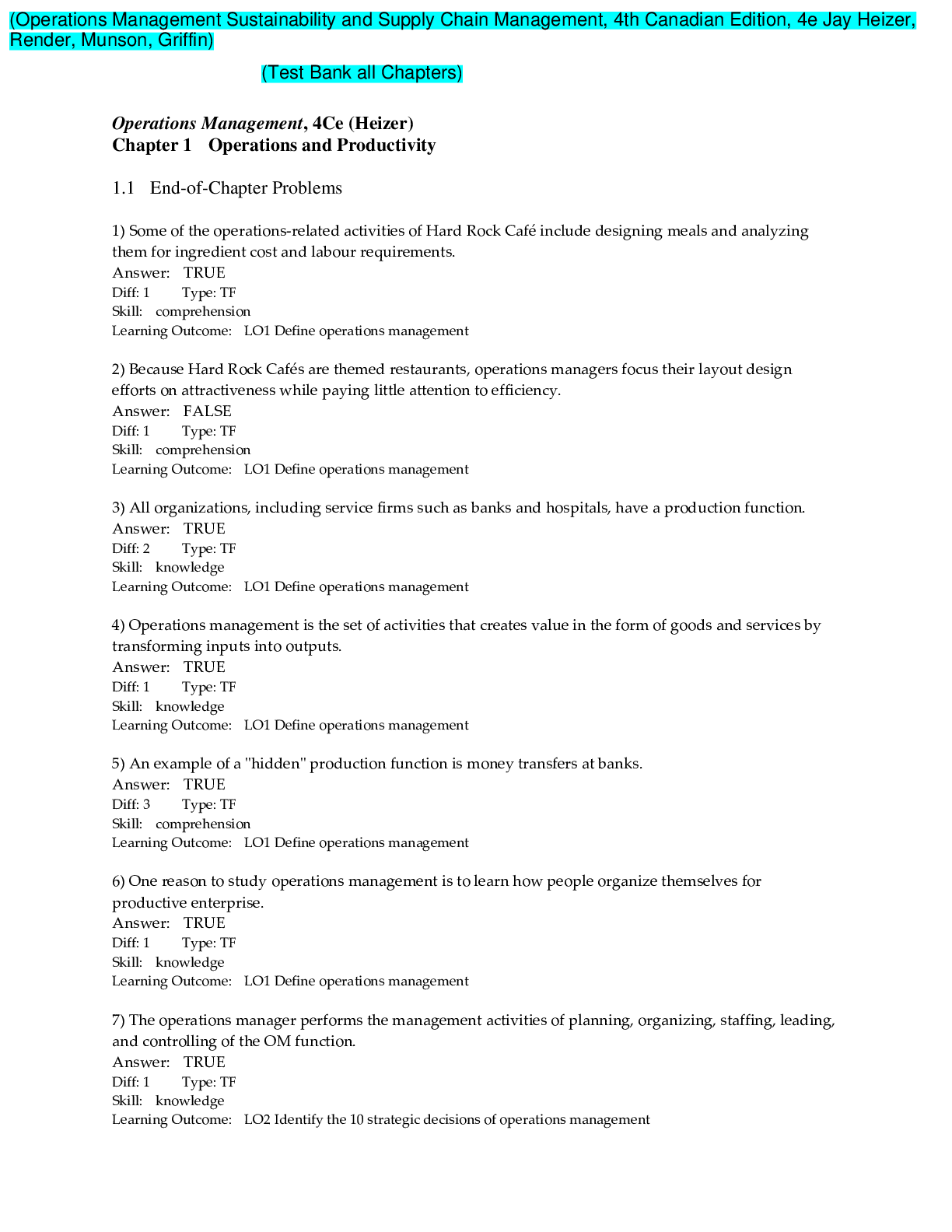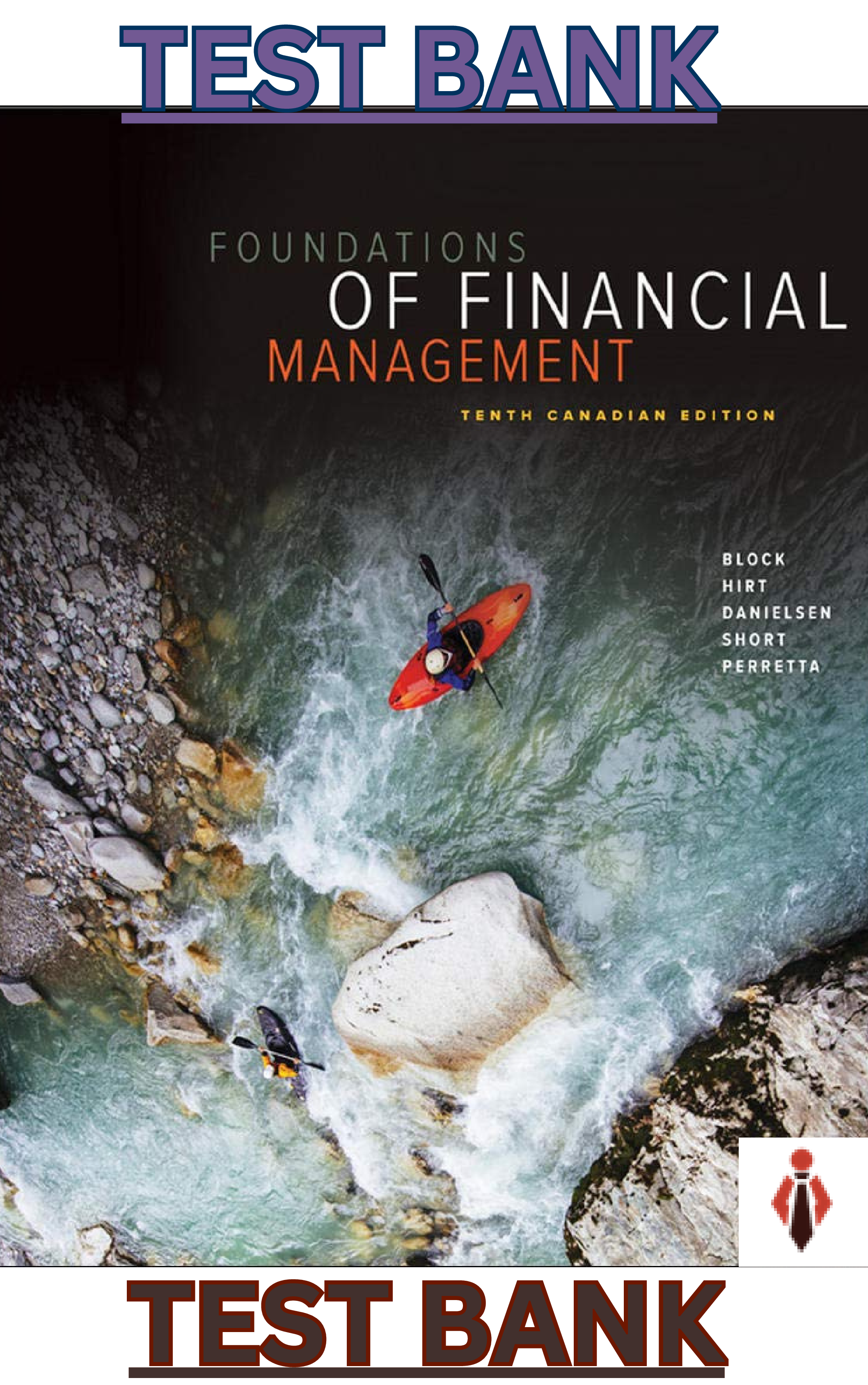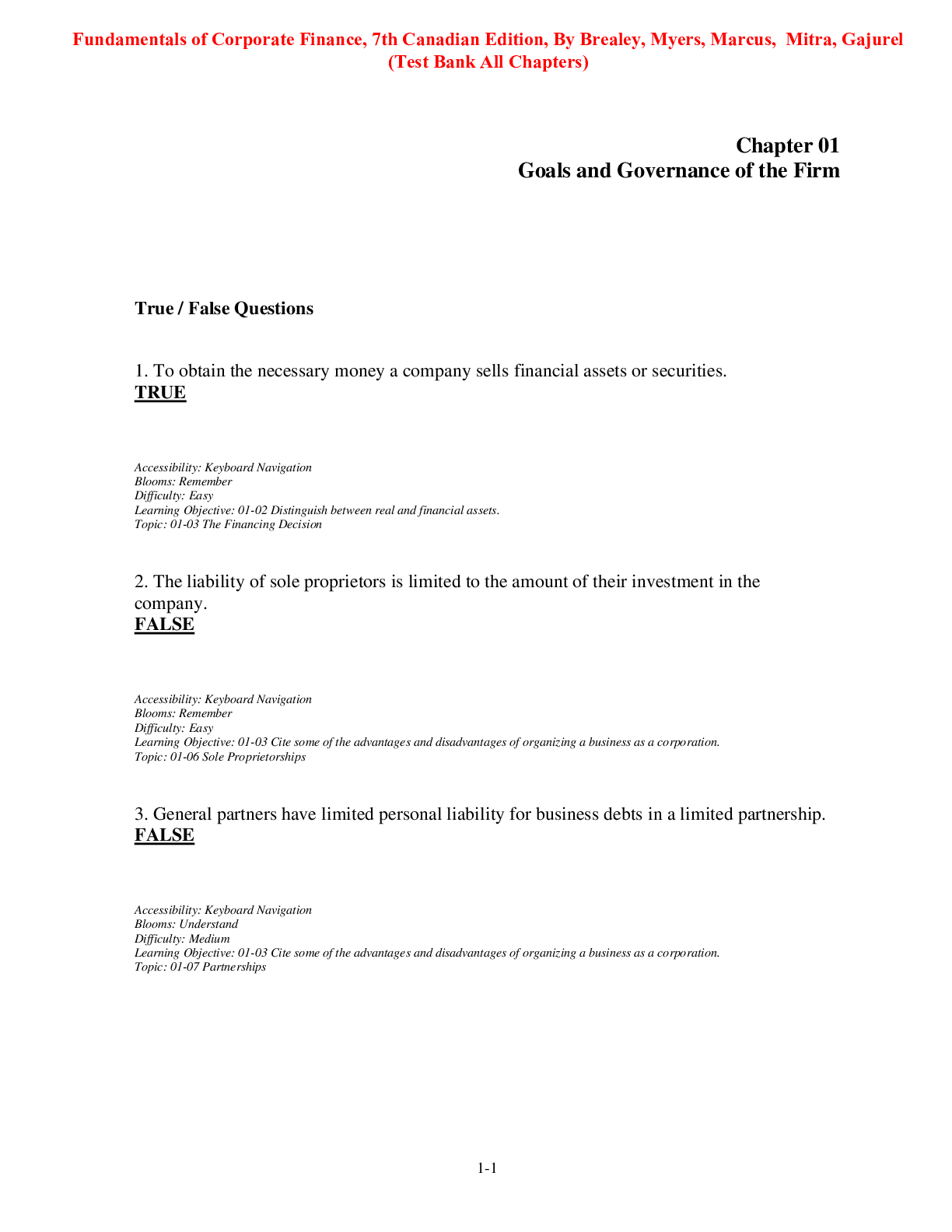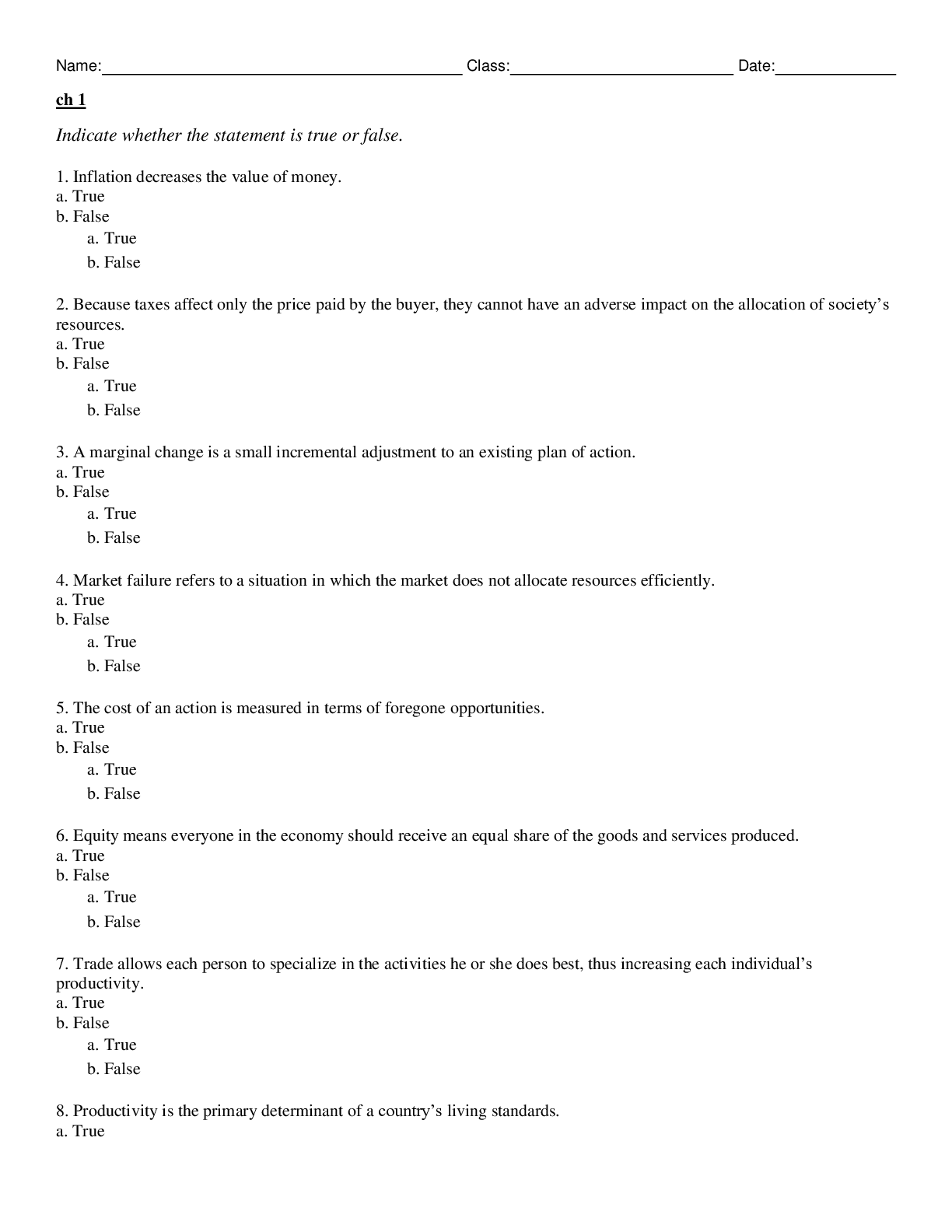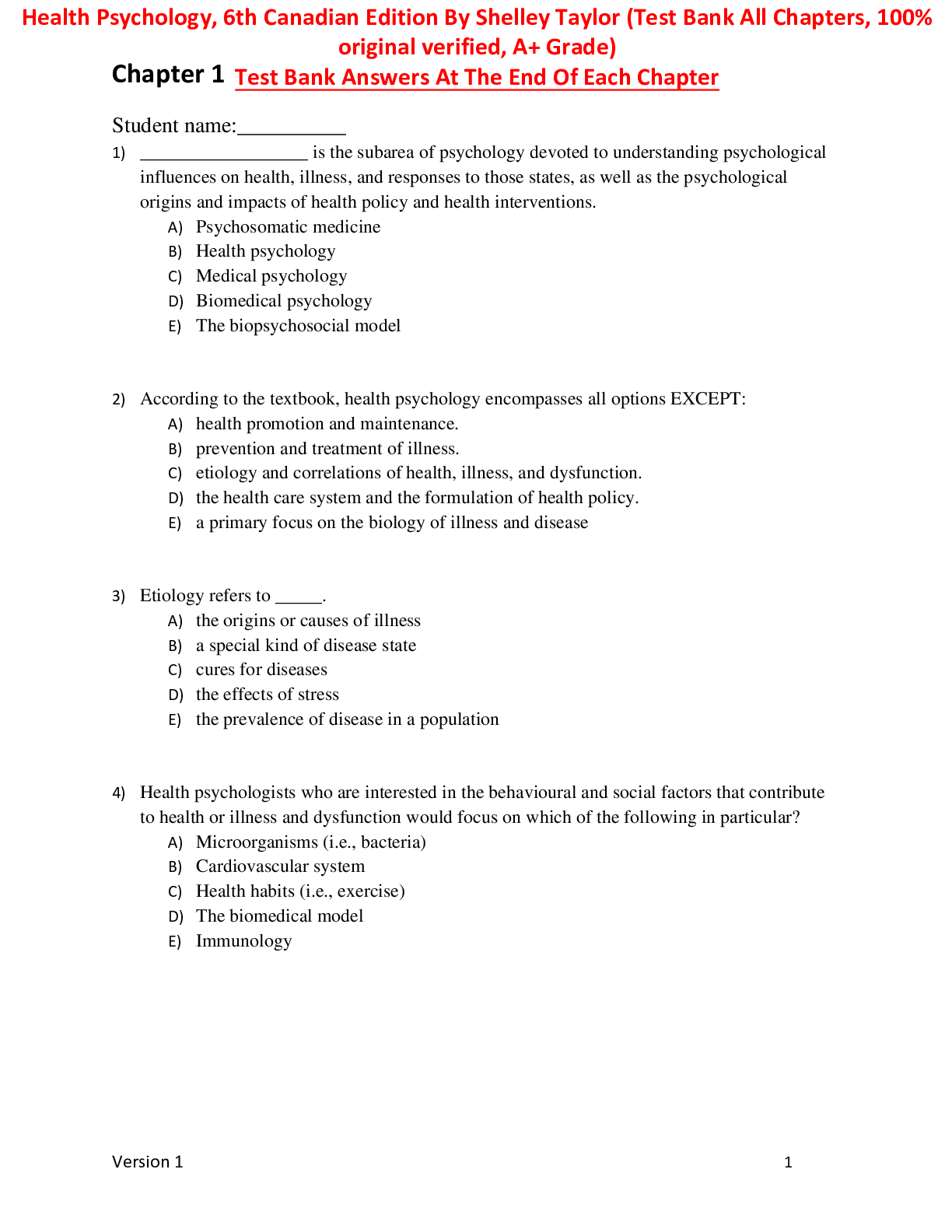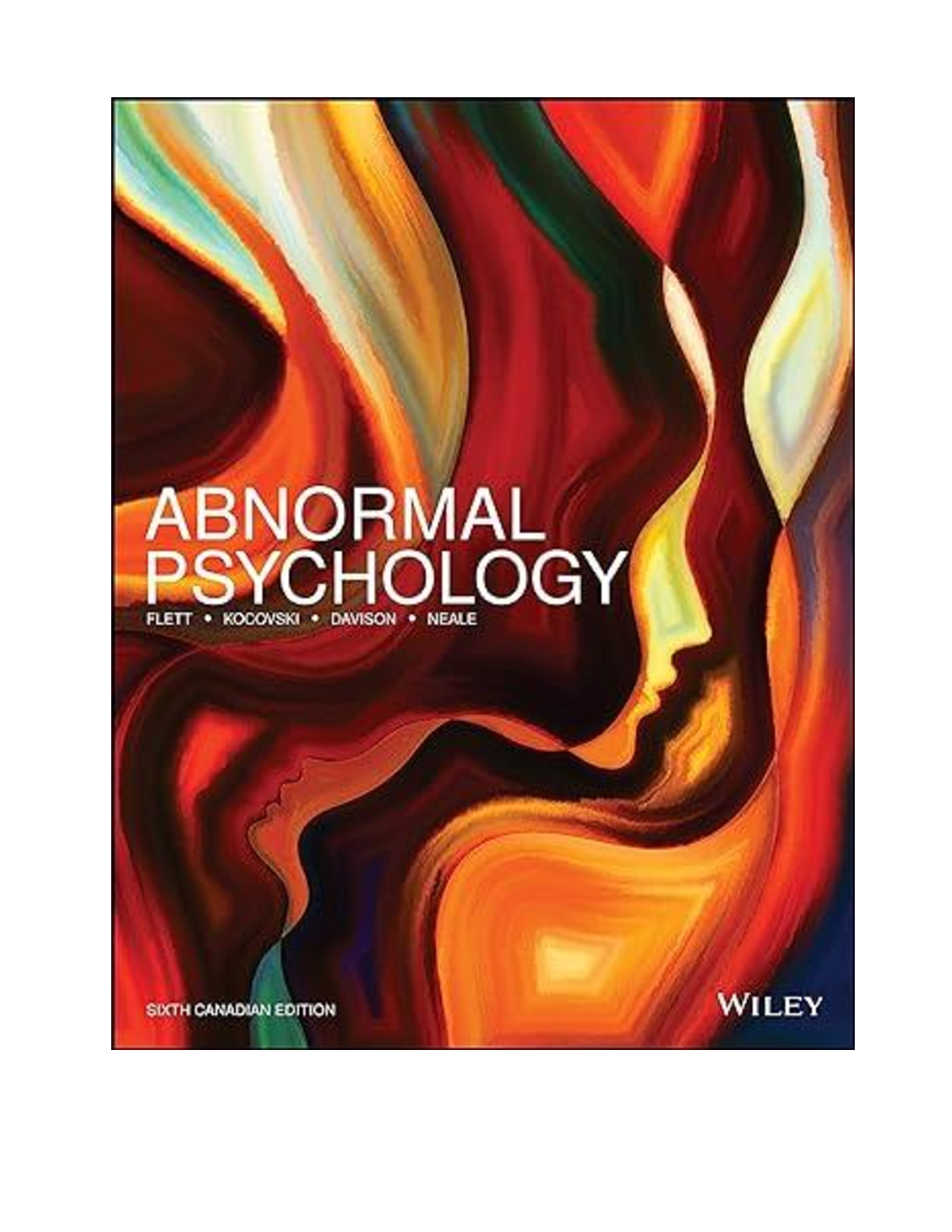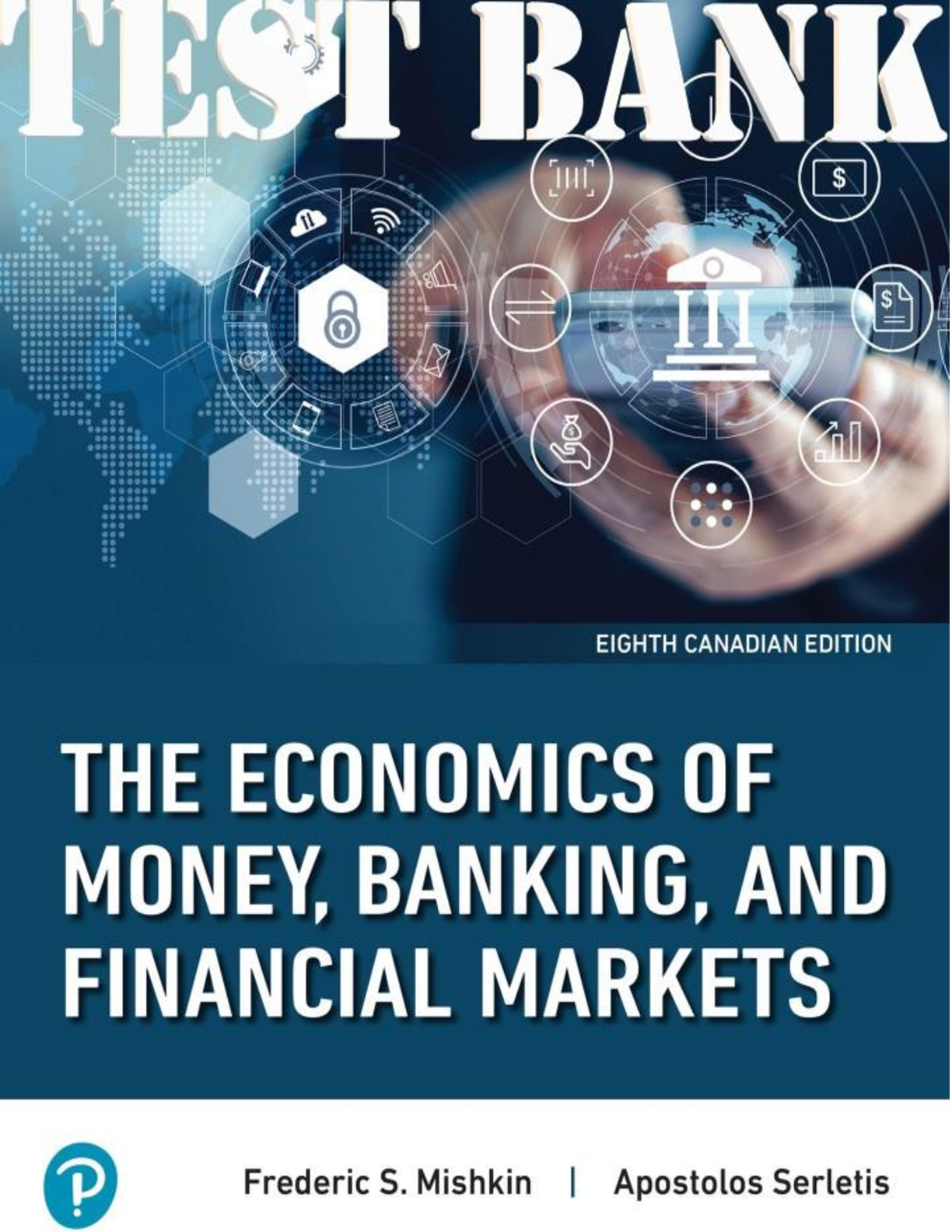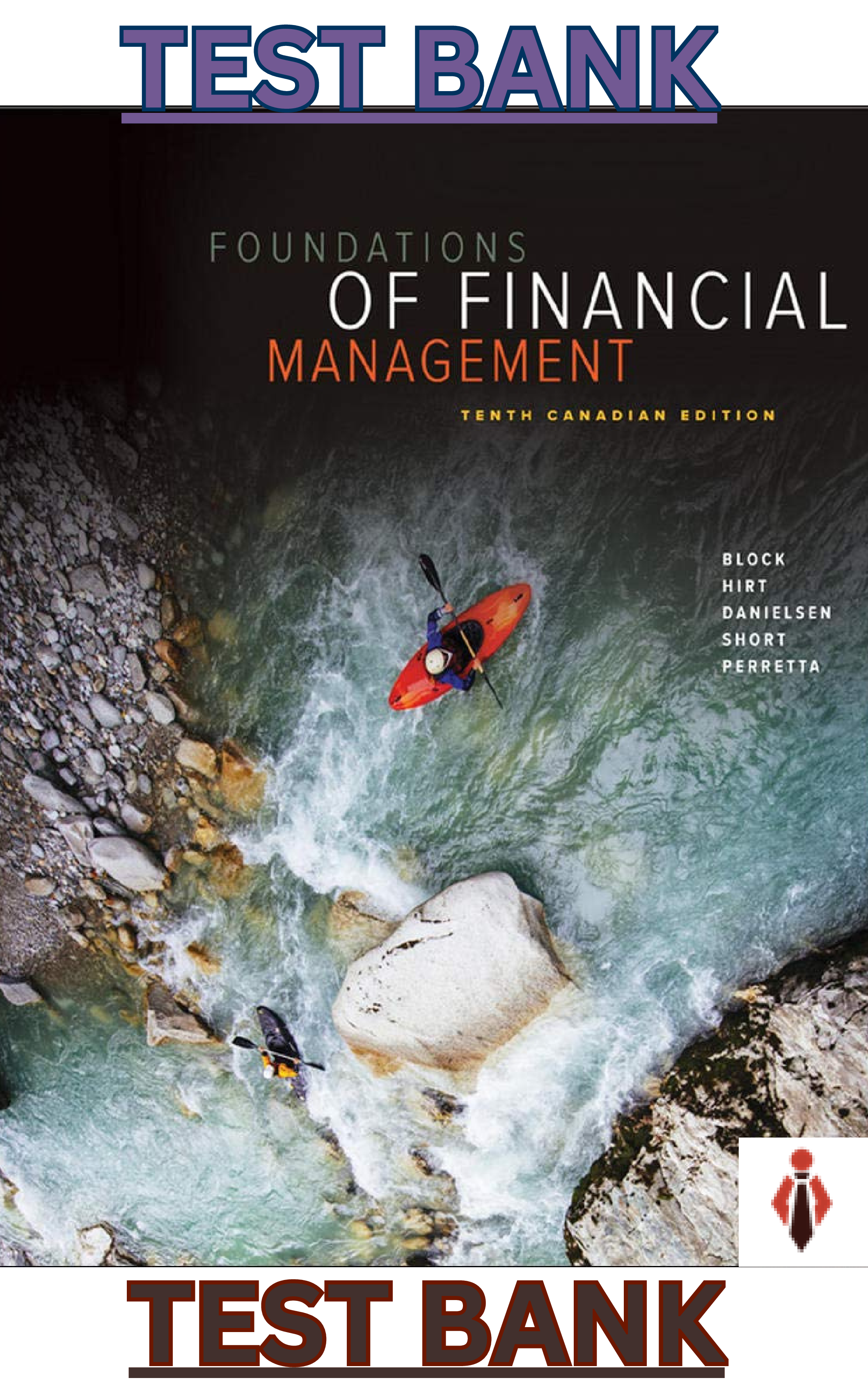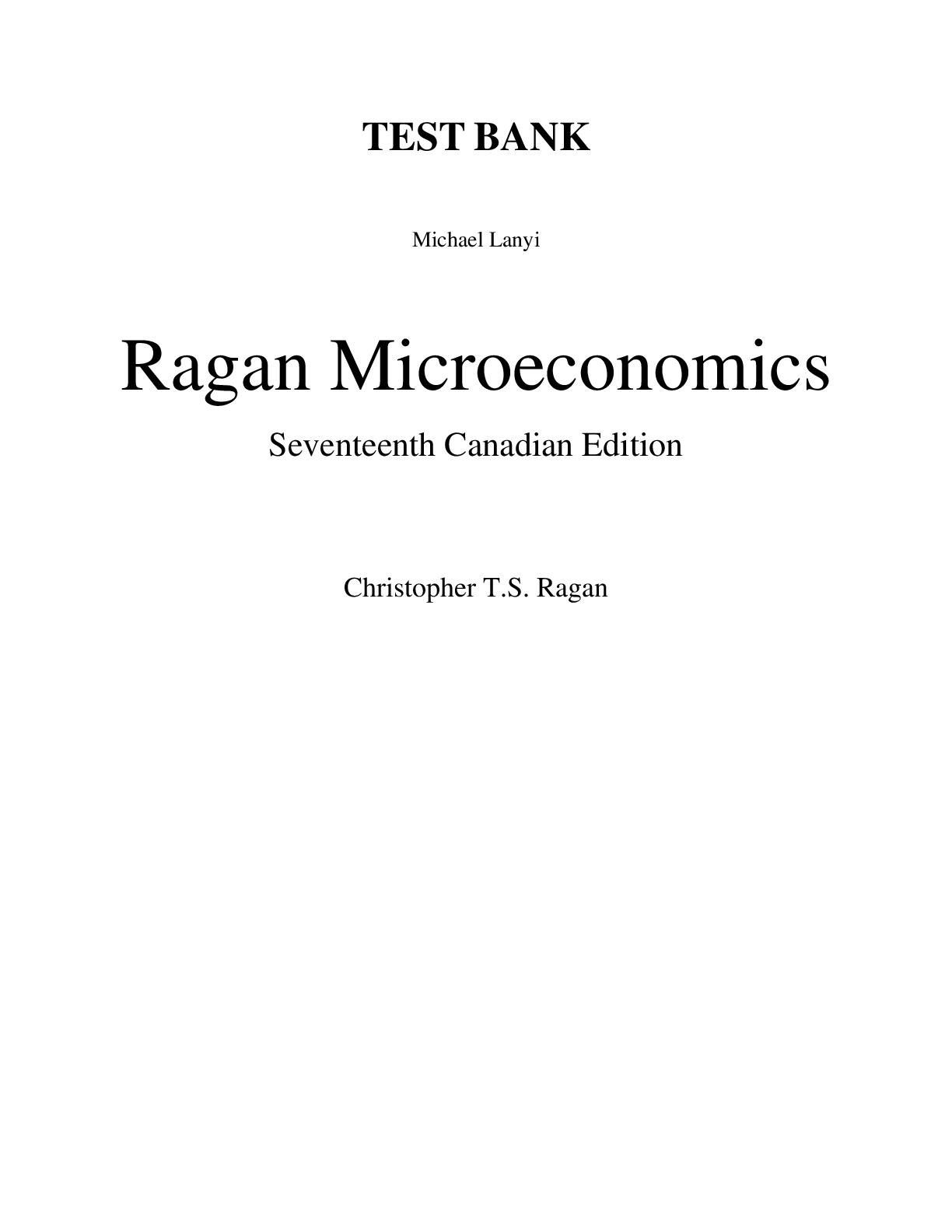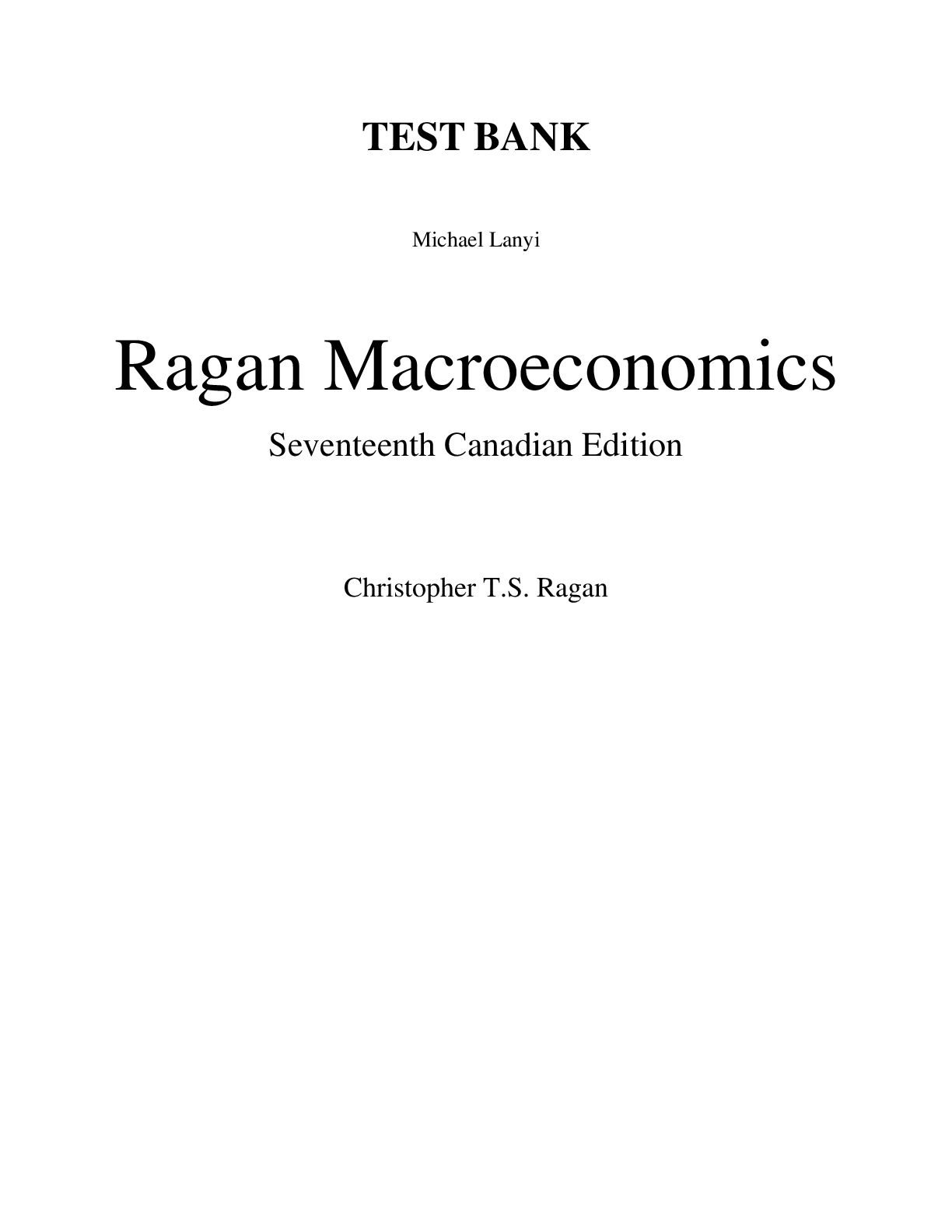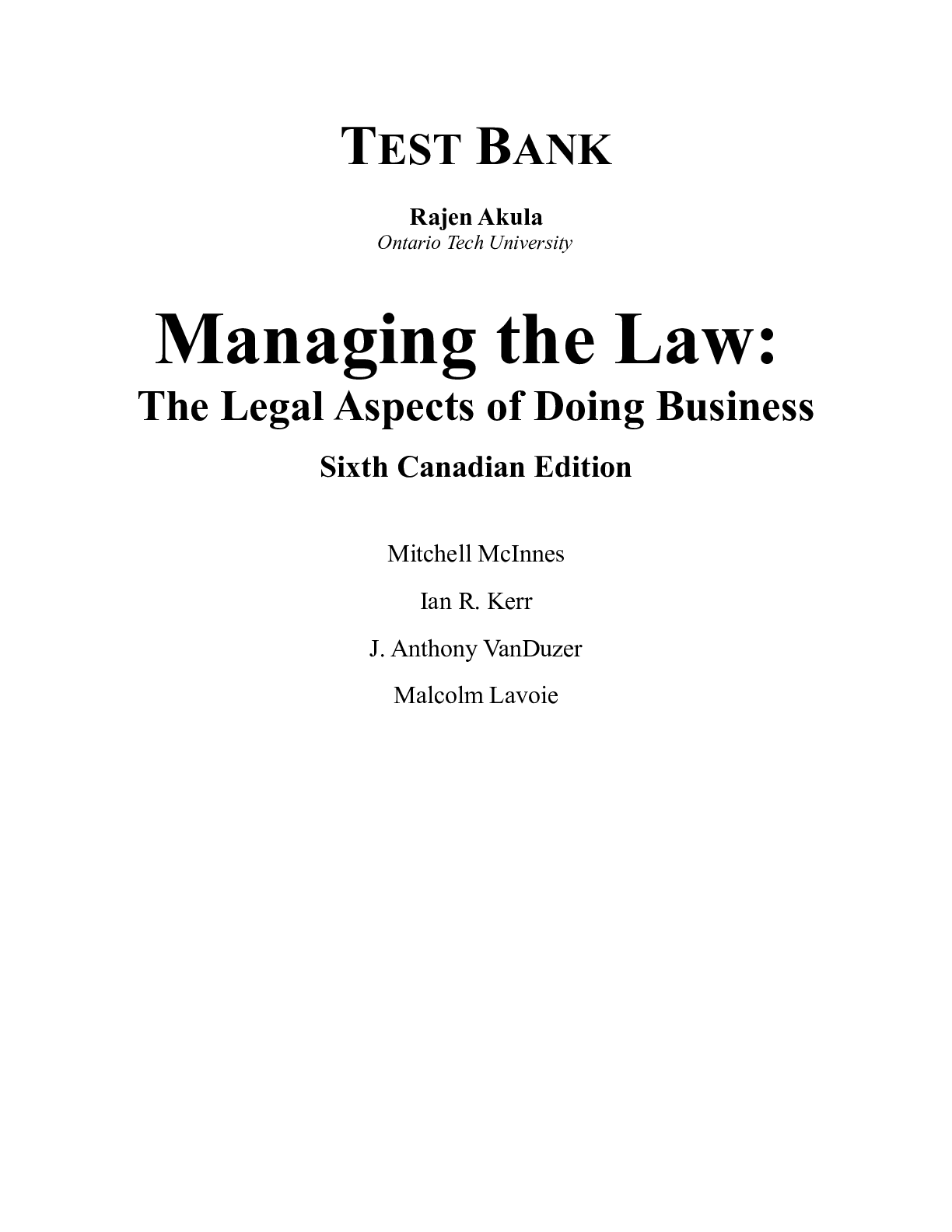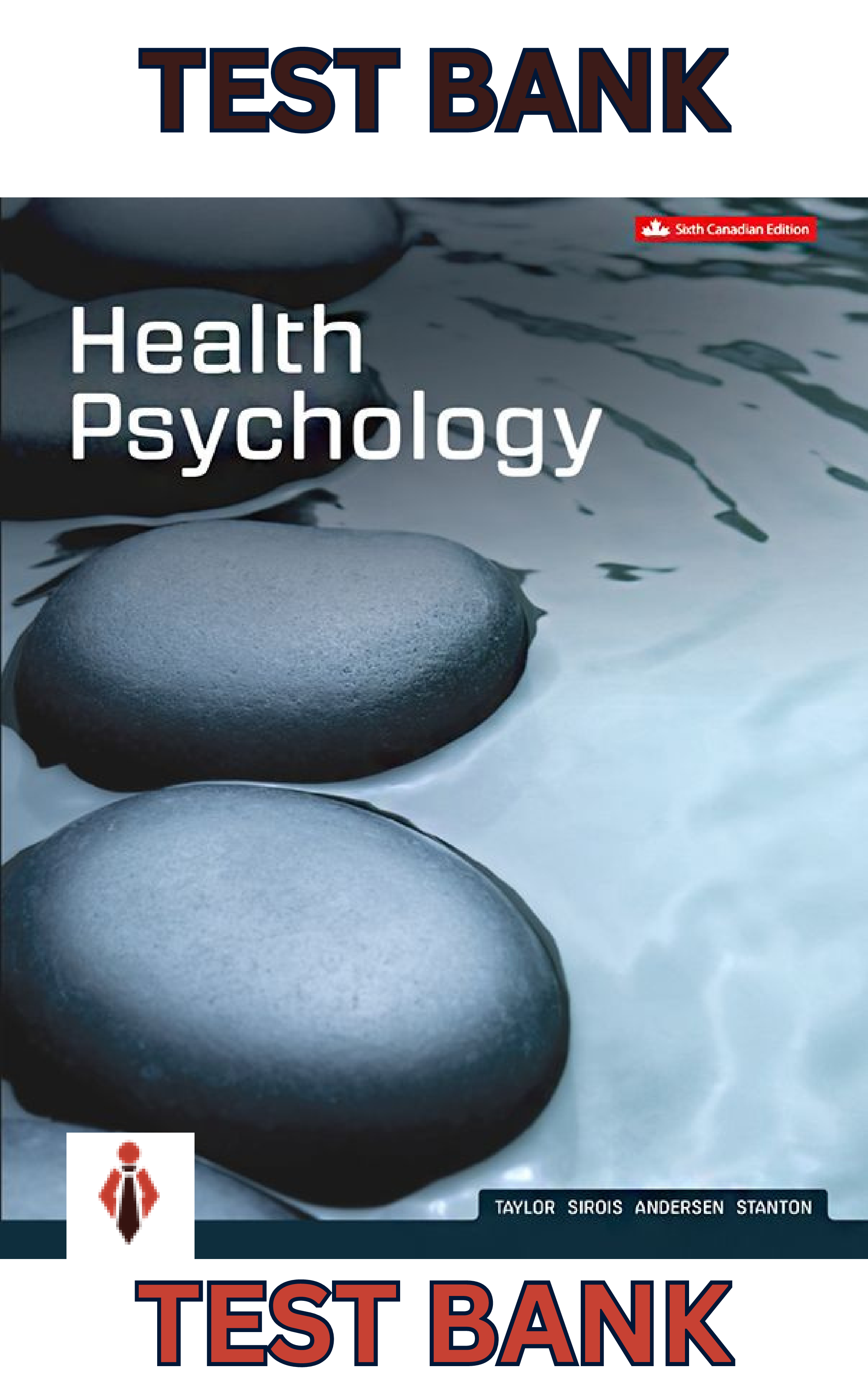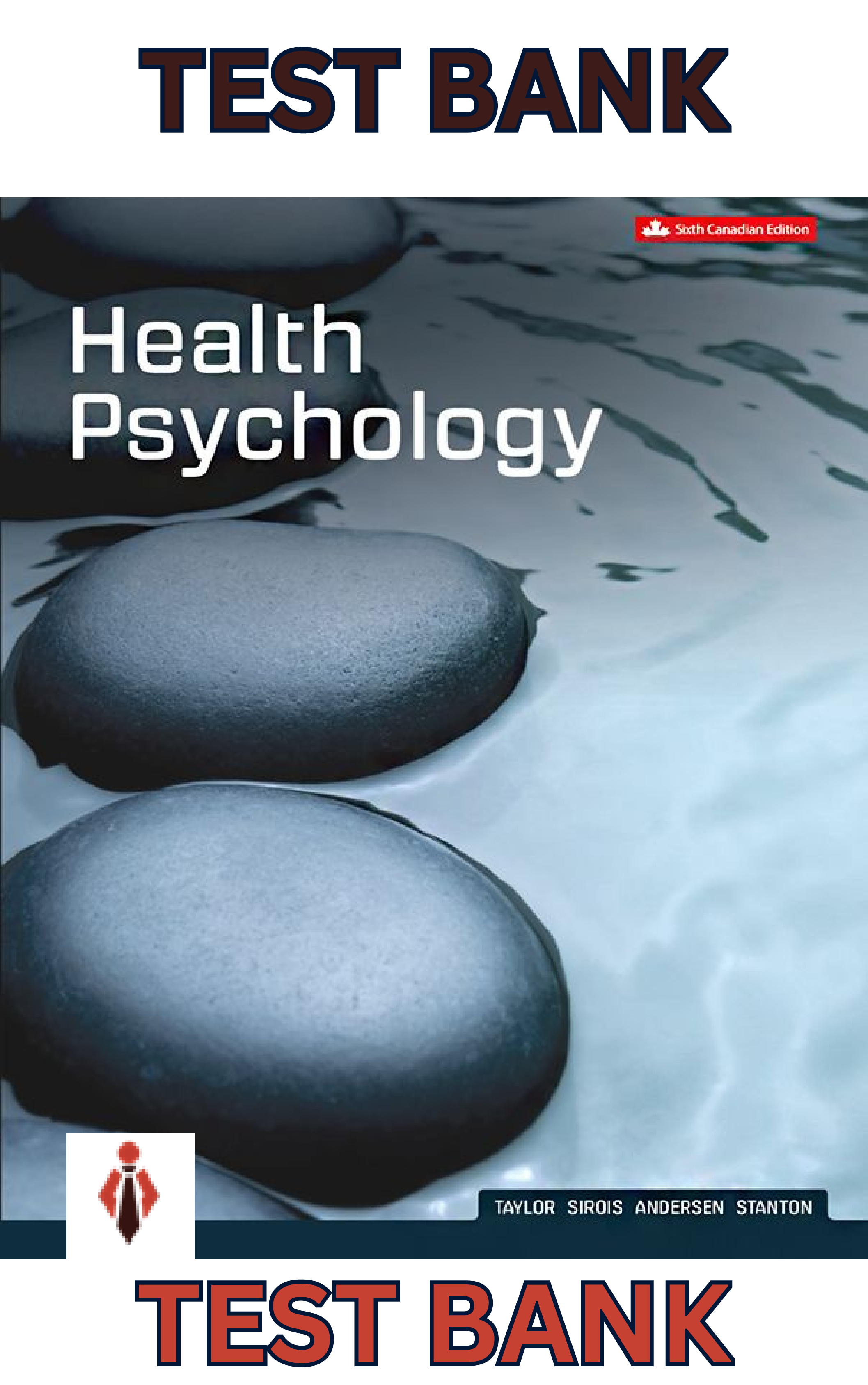TEST BANK for Macroeconomics, 6th Canadian Edition by Mankiw
Document Content and Description Below
Test Bank for Macroeconomics, 6th Canadian Edition, 6ce by N. Gregory Mankiw,William M. Scarth TEST BANK ISBN-13: 9781319115593 Full chapters included Part I Introduction Chapter 1 The Science... of Macroeconomics 1-1 What Macroeconomists Study 1-2 How Economists Think Theory as Model Building The Use of Multiple Models Prices: Flexible Versus Sticky Microeconomic Thinking and Macroeconomic Models 1-3 How This Book Proceeds Quick Quiz Summary Key Concepts Questions for Review Problems and Applications Answers to Quick Quiz Chapter 2 The Data of Macroeconomics 2-1 Measuring the Value of Economic Activity: Gross Domestic Product Income, Expenditure, and the Circular Flow Rules for Computing GDP Real GDP Versus Nominal GDP The GDP Deflator Chain-Weighted Measures of Real GDP The Components of Expenditure Other Measures of Income Seasonal Adjustment 2-2 Measuring the Cost of Living: The Consumer Price Index The Price of a Basket of Goods How the CPI Compares to the GDP Deflator Difficulties in Measuring Inflation 2-3 Measuring Joblessness: The Unemployment Rate The Labour Force Survey Survey of Employment, Payrolls, and Hours 2-4 Conclusion: From Economic Statistics to Economic Models Quick Quiz Summary Key Concepts Questions for Review Problems and Applications Answers to Quick Quiz Part II Classical Theory: The Economy in the Long Run Chapter 3 National Income: Where It Comes From and Where It Goes 3-1 What Determines the Total Production of Goods and Services? The Factors of Production The Production Function The Supply of Goods and Services 3-2 How Is National Income Distributed to the Factors of Production? Factor Prices The Decisions Facing a Competitive Firm The Firm’s Demand for Factors The Division of National Income The Cobb–Douglas Production Function 3-3 What Determines the Demand for Goods and Services? Consumption Investment Government Purchases 3-4 What Brings the Supply and Demand for Goods and Services into Equilibrium? Equilibrium in the Market for Goods and Services: The Supply and Demand for the Economy’s Output Equilibrium in the Financial Markets: The Supply and Demand for Loanable Funds Changes in Saving: The Effects of Fiscal Policy Changes in Investment Demand 3-5 Conclusion Quick Quiz Summary Key Concepts Questions for Review Problems and Applications Answers to Quick Quiz Chapter 4 The Monetary System: What It Is and How It Works 4-1 What Is Money? The Functions of Money The Types of Money The Development of Fiat Money How the Quantity of Money Is Controlled How the Quantity of Money Is Measured 4-2 The Role of Banks in the Monetary System 100-Percent-Reserve Banking Fractional-Reserve Banking Bank Capital, Leverage, and Capital Requirements 4-3 How Central Banks Influence the Money Supply A Model of the Money Supply The Instruments of Monetary Policy 4-4 Conclusion Quick Quiz Summary Key Concepts Questions for Review Problems and Applications Answers to Quick Quiz Chapter 5 Inflation: Its Causes, Effects, and Social Costs 5-1 The Quantity Theory of Money Transactions and the Quantity Equation From Transactions to Income The Money Demand Function and the Quantity Equation The Assumption of Constant Velocity Money, Prices, and Inflation 5-2 Seigniorage: The Revenue from Printing Money 5-3 Inflation and Interest Rates Two Interest Rates: Real and Nominal The Fisher Effect Two Real Interest Rates: Ex Ante and Ex Post 5-4 The Nominal Interest Rate and the Demand for Money The Cost of Holding Money Future Money and Current Prices 5-5 The Social Costs of Inflation The Layman’s View and the Classical Response The Costs of Expected Inflation The Costs of Unexpected Inflation One Benefit of Inflation 5-6 Hyperinflation The Costs of Hyperinflation The Causes of Hyperinflation 5-7 Conclusion: The Classical Dichotomy Quick Quiz Summary Key Concepts Questions for Review Problems and Applications Answers to Quick Quiz Chapter 6 The Open Economy 6-1 The International Flows of Capital and Goods The Role of Net Exports International Capital Flows and the Trade Balance International Flows of Goods and Capital: An Example The Irrelevance of Bilateral Trade Balances 6-2 Saving and Investment in a Small Open Economy Capital Mobility and the World Interest Rate The Model How Policies Influence the Trade Balance Evaluating Economic Policy 6-3 Exchange Rates Nominal and Real Exchange Rates The Real Exchange Rate and the Trade Balance The Determinants of the Real Exchange Rate How Policies Influence the Real Exchange Rate The Effects of Trade Policies The Determinants of the Nominal Exchange Rate The Special Case of Purchasing-Power Parity 6-4 Conclusion: The United States as a Large Open Economy Quick Quiz Summary Key Concepts Questions for Review Problems and Applications Answers to Quick Quiz Appendix: The Open Economy in the Very Long Run Foreign Debt Fiscal Policy Trickle-Down Economics Trump’s Tax Changes and Canadian Incomes Chapter 7 Unemployment and the Labour Market 7-1 Job Loss, Job Finding, and the Natural Rate of Unemployment 7-2 Job Search and Frictional Unemployment Causes of Frictional Unemployment Public Policy and Frictional Unemployment 7-3 Real-Wage Rigidity and Structural Unemployment Minimum-Wage Laws Unions and Collective Bargaining Efficiency Wages 7-4 Labour Market Experience: Canada The Duration of Unemployment Variation in the Unemployment Rate Across Age Groups and Regions Trends in Unemployment Transitions into and out of the Labour Force 7-5 Labour-Market Experience: Europe The Rise in European Unemployment Unemployment Variation Within Europe The Rise of European Leisure 7-6 Conclusion Quick Quiz Summary Key Concepts Questions for Review Problems and Applications Answers to Quick Quiz Appendix: Unemployment, Inequality, and Government Policy More Generous EI Canada Worker Benefit (CWB) An Employer Subsidy for Hiring Low-Skilled Individuals Summing Up More Problems and Applications Part III Growth Theory: The Economy in the Very Long Run Chapter 8 Economic Growth I: Capital Accumulation and Population Growth 8-1 The Accumulation of Capital The Supply and Demand for Goods Growth in the Capital Stock and the Steady State Approaching the Steady State: A Numerical Example How Saving Affects Growth 8-2 The Golden Rule Level of Capital Comparing Steady States Finding the Golden Rule Steady State: A Numerical Example The Transition to the Golden Rule Steady State 8-3 Population Growth The Steady State with Population Growth The Effects of Population Growth Alternative Perspectives on Population Growth 8-4 Conclusion Quick Quiz Summary Key Concepts Questions for Review Problems and Applications Answers to Quick Quiz Chapter 9 Economic Growth II: Technology, Empirics, and Policy 9-1 Technological Progress in the Solow Model The Efficiency of Labour The Steady State with Technological Progress The Effects of Technological Progress 9-2 From Growth Theory to Growth Empirics Balanced Growth Convergence Factor Accumulation versus Production Efficiency 9-3 Policies to Promote Growth Evaluating the Rate of Saving Changing the Rate of Saving Allocating the Economy’s Investment Establishing the Right Institutions Supporting a Pro-growth Culture Encouraging Technological Progress 9-4 Beyond the Solow Model: Endogenous Growth Theory The Basic Model A Two-Sector Model The Microeconomics of Research and Development The Process of Creative Destruction Limits to Growth 9-5 Conclusion Quick Quiz Summary Key Concepts Questions for Review Problems and Applications Answers to Quick Quiz Appendix: Accounting for the Sources of Economic Growth Increases in the Factors of Production Increases in Capital Increases in Labour Increases in Capital and Labour Technological Progress The Sources of Growth in Canada The Solow Residual in the Short Run More Problems and Applications Part IV Business Cycle Theory: The Economy in the Short Run Chapter 10 Introduction to Economic Fluctuations 10-1 The Facts About the Business Cycle GDP and Its Components Unemployment, GDP, and Okun’s Law Leading Economic Indicators 10-2 Time Horizons in Macroeconomics How the Short Run and the Long Run Differ The Model of Aggregate Supply and Aggregate Demand 10-3 Aggregate Demand The Quantity Equation as Aggregate Demand Why the Aggregate Demand Curve Slopes Downward Shifts in the Aggregate Demand Curve 10-4 Aggregate Supply The Long Run: The Vertical Aggregate Supply Curve The Short Run: The Horizontal Aggregate Supply Curve From the Short Run to the Long Run 10-5 Stabilization Policy Shocks to Aggregate Demand Shocks to Aggregate Supply 10-6 Conclusion Quick Quiz Summary Key Concepts Questions for Review Problems and Applications Answers to Quick Quiz Chapter 11 Aggregate Demand I: Building the IS–LM Model 11-1 The Goods Market and the IS Curve The Keynesian Cross The Interest Rate, Investment, and the IS Curve How Fiscal Policy Shifts the IS Curve 11-2 The Money Market and the LM Curve The Theory of Liquidity Preference Income, Money Demand, and the LM Curve How Monetary Policy Shifts the LM Curve 11-3 Conclusion: The Short-Run Equilibrium Quick Quiz Summary Key Concepts Questions for Review Problems and Applications Answers to Quick Quiz Chapter 12 Aggregate Demand II: Applying the IS–LM Model 12-1 Explaining Fluctuations with the IS–LM Model How Fiscal Policy Shifts the IS Curve and Changes the Short-Run Equilibrium How Monetary Policy Shifts the LM Curve and Changes the Short-Run Equilibrium The Interaction Between Monetary and Fiscal Policy Shocks in the IS–LM Model What Is the Bank of Canada’s Policy Instrument—the Money Supply or the Interest Rate? And What Is Quantitative Easing? 12-2 IS–LM as a Theory of Aggregate Demand From the IS–LM Model to the Aggregate Demand Curve The IS–LM Model in the Short Run and Long Run 12-3 The Great Depression The Spending Hypothesis: Shocks to the IS Curve The Money Hypothesis: A Shock to the LM Curve The Money Hypothesis Again: The Effects of Falling Prices Could the Depression Happen Again? The Liquidity Trap (Also Known as the Zero Lower Bound) 12-4 Conclusion Quick Quiz Summary Key Concepts Questions for Review Problems and Applications Answers to Quick Quiz Appendix: Aggregate Demand Theory Without the LM Curve Aggregate Demand in a Closed Economy Aggregate Demand in a Small Open Economy Chapter 13 The Open Economy Revisited: The Mundell–Fleming Model and the Exchange-Rate Regime 13-1 The Mundell–Fleming Model The Key Assumption: Small Open Economy with Perfect Capital Mobility The Goods Market and the IS* Curve The Money Market and the LM* Curve Putting the Pieces Together 13-2 The Small Open Economy Under Floating Exchange Rates Fiscal Policy Monetary Policy Trade Policy World Interest-Rate Changes 13-3 The Small Open Economy Under Fixed Exchange Rates How a Fixed-Exchange-Rate System Works Fiscal Policy Monetary Policy Trade Policy 13-4 World Interest-Rate Changes Policy in the Mundell–Fleming Model: A Summary 13-5 Interest Rate Differentials Country Risk and Exchange-Rate Expectations Differentials in the Mundell–Fleming Model 13-6 Should Exchange Rates Be Floating or Fixed? Pros and Cons of Different Exchange-Rate Systems Speculative Attacks, Currency Boards, and Dollarization The Impossible Trinity 13-7 From the Short Run to the Long Run: The Mundell–Fleming Model with a Changing Price Level 13-8 A Concluding Reminder Quick Quiz Summary Key Concepts Questions for Review Problems and Applications Answers to Quick Quiz Appendix: Extensions to the Mundell–Fleming Model The Exchange Rate and the CPI Flexible Domestic Prices Exchange-Rate Expectations An Attempt at Perspective More Problems and Applications Chapter 14 Aggregate Supply and the Short-Run Tradeoff Between Inflation and Unemployment 14-1 The Basic Theory of Aggregate Supply The Sticky-Price Model An Alternative Theory: The Imperfect-Information Model Implications 14-2 Inflation, Unemployment, and the Phillips Curve Deriving the Phillips Curve from the Aggregate Supply Curve Adaptive Expectations and Inflation Inertia Two Causes of Rising and Falling Inflation The Short-Run Tradeoff Between Inflation and Unemployment Disinflation and the Sacrifice Ratio Rational Expectations and the Possibility of Painless Disinflation Challenges to the Natural-Rate Hypothesis 14-3 Conclusion Quick Quiz Summary Key Concepts Questions for Review Problems and Applications Answers to Quick Quiz Appendix: A Big, Comprehensive Model Special Case 1: The Classical Closed Economy Special Case 2: The Classical Small Open Economy Special Case 3: The Basic Model of Aggregate Demand and Aggregate Supply Special Case 4: The IS–LM Model Special Case 5: The Mundell–Fleming Model with a Floating Exchange Rate Special Case 6: The Mundell–Fleming Model with a Fixed Exchange Rate Part V Topics in Macroeconomic Theory and Policy Chapter 15 A Dynamic Model of Economic Fluctuations 15-1 Elements of the Model Output: The Demand for Goods and Services The Real Interest Rate: The Fisher Equation Inflation: The Phillips Curve Expected Inflation: Adaptive Expectations The Nominal Interest Rate: The Monetary-Policy Rule 15-2 Solving the Model The Long-Run Equilibrium The Dynamic Aggregate Supply Curve The Dynamic Aggregate Demand Curve The Short-Run Equilibrium 15-3 Using the Model Long-Run Growth A Shock to Aggregate Supply A Shock to Aggregate Demand A Shift in Monetary Policy 15-4 Two Applications: Lessons for Monetary Policy The Tradeoff Between Output Variability and Inflation Variability The Taylor Principle 15-5 Conclusion: Toward DSGE Models Quick Quiz Summary Key Concepts Questions for Review Problems and Applications Answers to Quick Quiz Chapter 16 Alternative Perspectives on Stabilization Policy 16-1 Should Policy Be Active or Passive? Lags in the Implementation and Effects of Policies The Difficult Job of Economic Forecasting Ignorance, Expectations, and the Lucas Critique The Historical Record 16-2 Should Policy Be Conducted by Rule or Discretion? Distrust of Policymakers and the Political Process The Time Inconsistency of Discretionary Policy Rules for Monetary Policy 16-3 Conclusion Quick Quiz Summary Key Concepts Questions for Review Problems and Applications Answers to Quick Quiz Appendix: Time Inconsistency and the Tradeoff Between Inflation and Unemployment More Problems and Applications Chapter 17 Government Debt and Budget Deficits 17-1 The Size of the Government Debt 17-2 Measurement Problems Problem 1: Inflation Problem 2: Capital Assets Problem 3: Uncounted Liabilities Problem 4: The Business Cycle Summing Up 17-3 The Traditional View of Government Debt 17-4 The Ricardian View of Government Debt The Basic Logic of Ricardian Equivalence Consumers and Future Taxes Making a Choice 17-5 Other Perspectives on Government Debt Balanced Budgets Versus Optimal Fiscal Policy Fiscal Effects on Monetary Policy Debt and the Political Process International Dimensions 17-6 Conclusion Quick Quiz Summary Key Concepts Questions for Review Problems and Applications Answers to Quick Quiz Appendix: Estimating the Benefits of Deficit and Debt Reduction Chapter 18 The Financial System: Opportunities and Dangers 18-1 What Does the Financial System Do? Financing Investment Sharing Risk Dealing with Asymmetric Information Fostering Economic Growth 18-2 Financial Crises The Anatomy of a Crisis Policy Responses to a Crisis Policies to Prevent Crises 18-3 Conclusion Quick Quiz Summary Key Concepts Questions for Review Problems and Applications Answers to Quick Quiz Chapter 19 The Microfoundations of Consumption and Investment 19-1 What Determines Consumer Spending? John Maynard Keynes and the Consumption Function Franco Modigliani and the Life-Cycle Hypothesis Milton Friedman and the Permanent-Income Hypothesis Robert Hall and the Random-Walk Hypothesis David Laibson and the Pull of Instant Gratification The Bottom Line on Consumption 19-2 What Determines Investment Spending? The Rental Price of Capital The Cost of Capital The Cost-Benefit Calculus of Investment Taxes and Investment The Stock Market and Tobin’s q Financing Constraints Banking Crises and Credit Crunches The Botto [Show More]
Last updated: 3 weeks ago
Preview 1 out of 528 pages
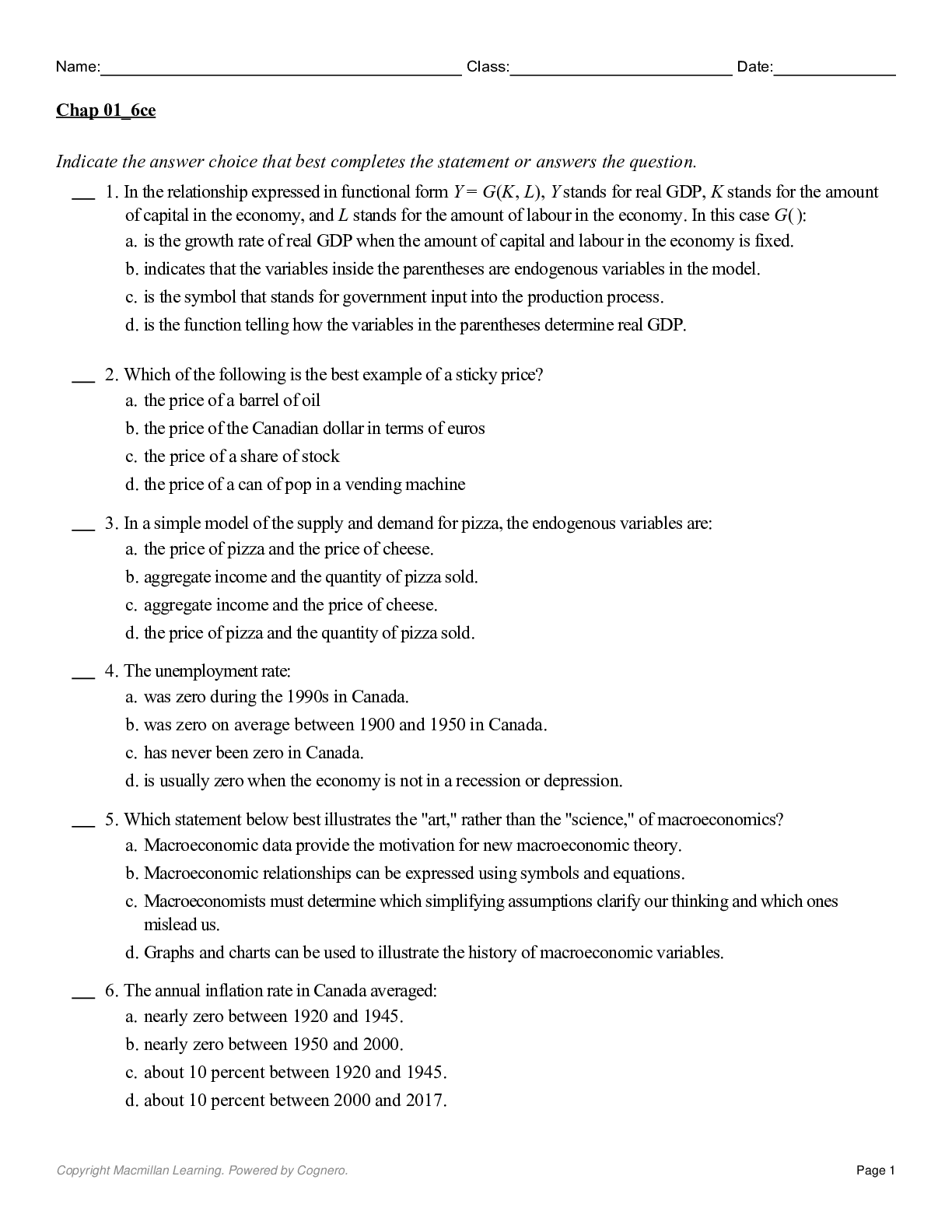
Reviews( 0 )
Document information
Connected school, study & course
About the document
Uploaded On
Sep 07, 2022
Number of pages
528
Written in
Additional information
This document has been written for:
Uploaded
Sep 07, 2022
Downloads
0
Views
130



